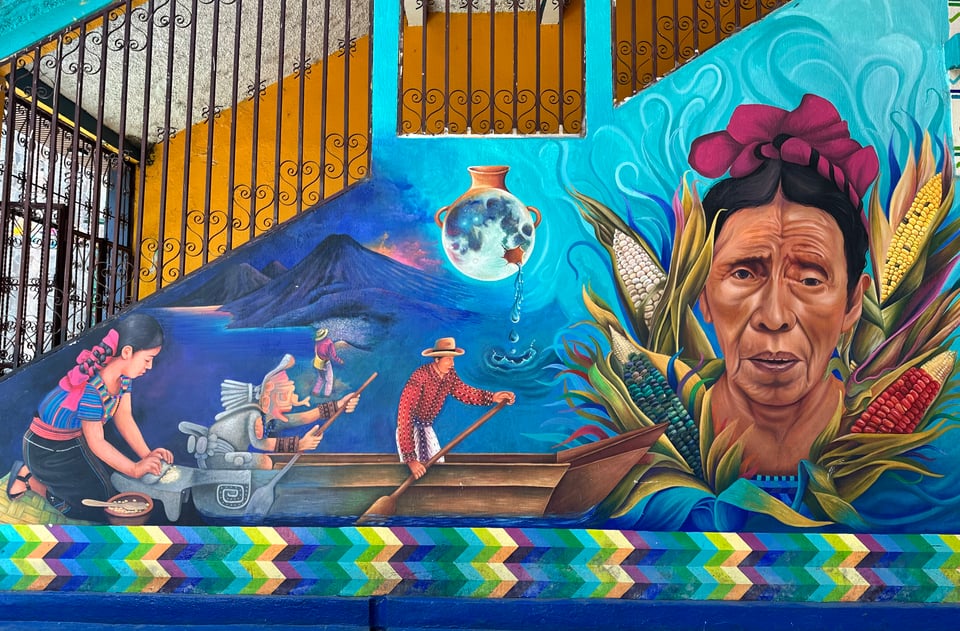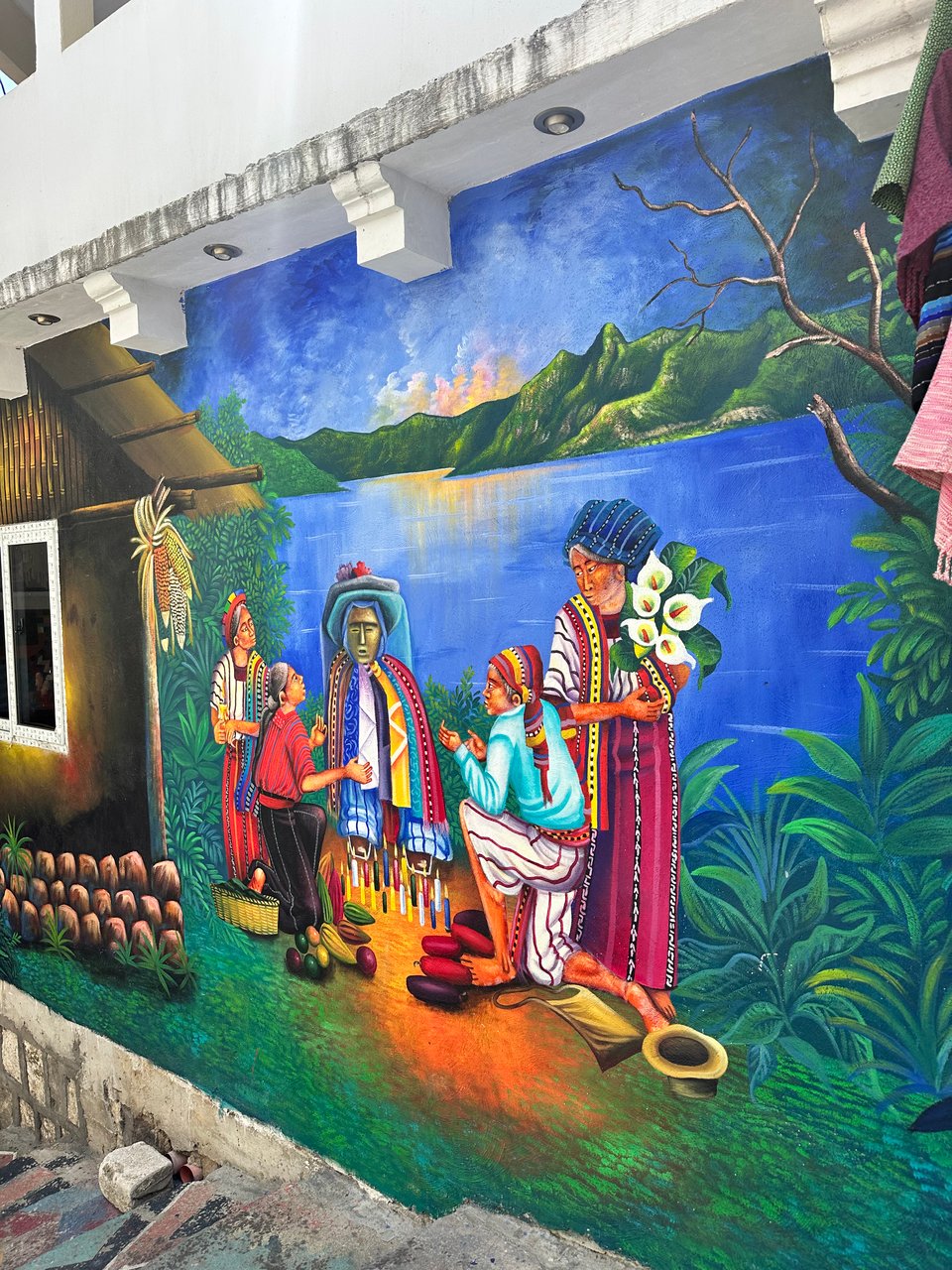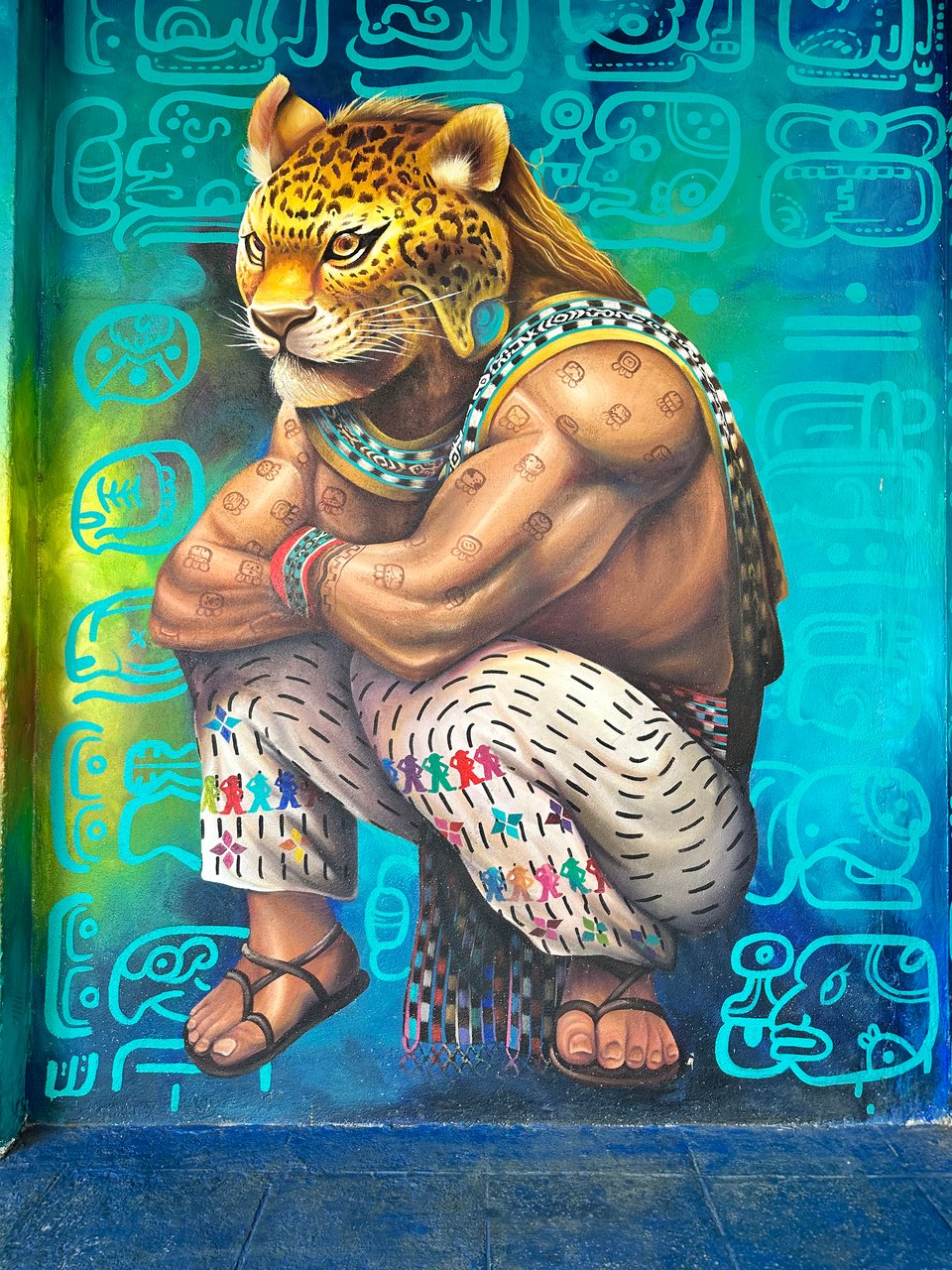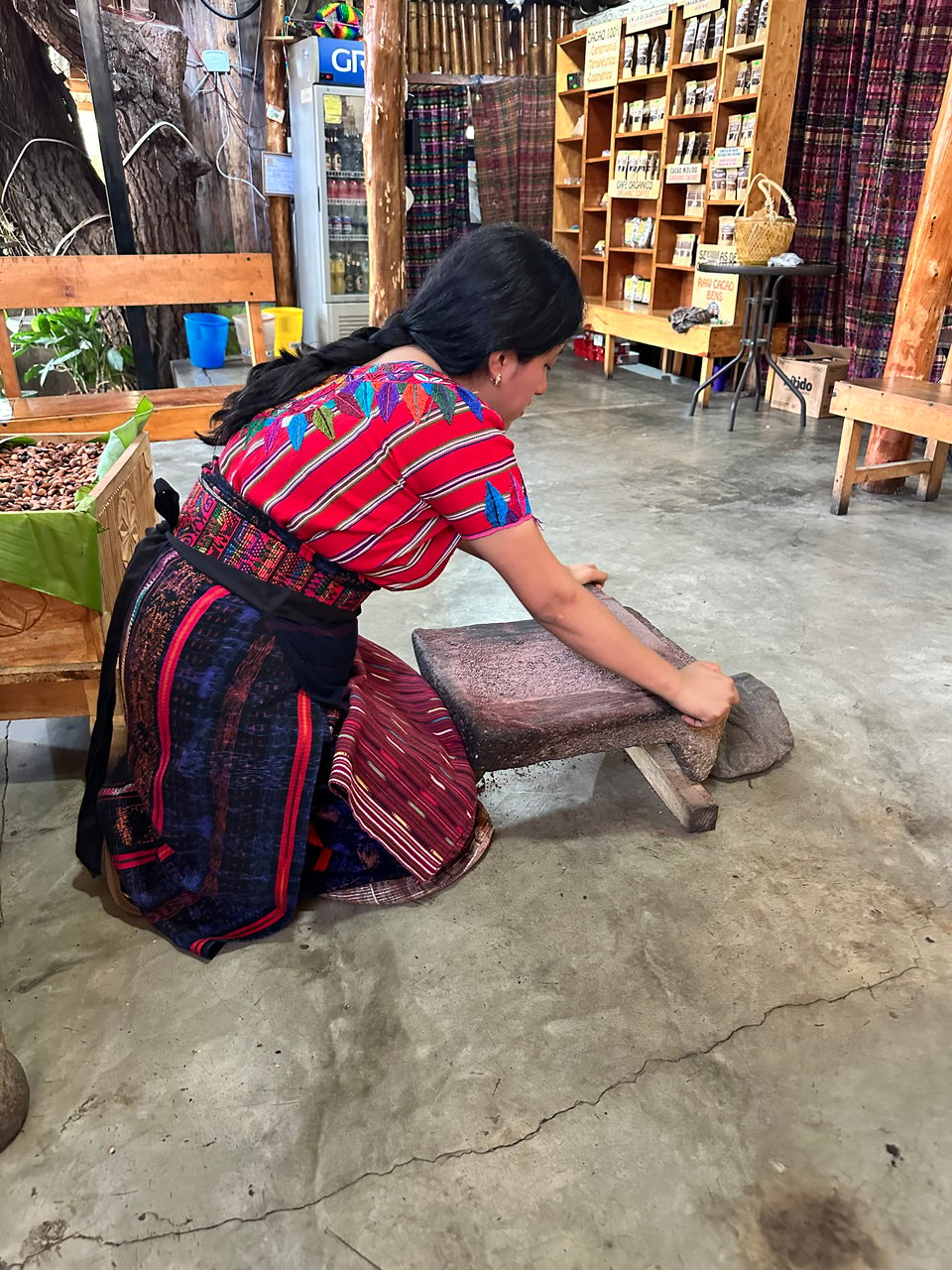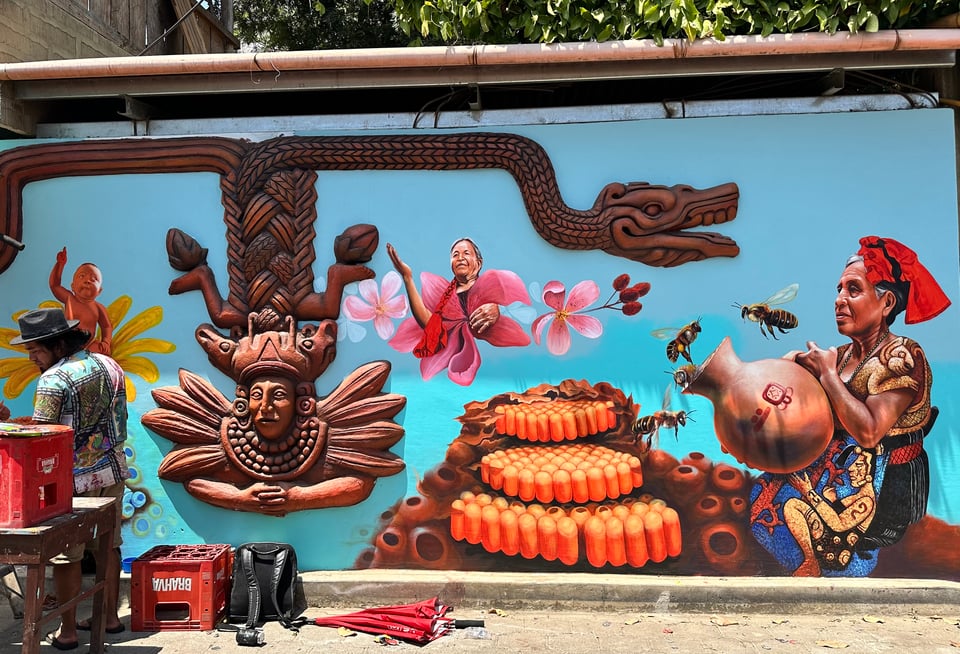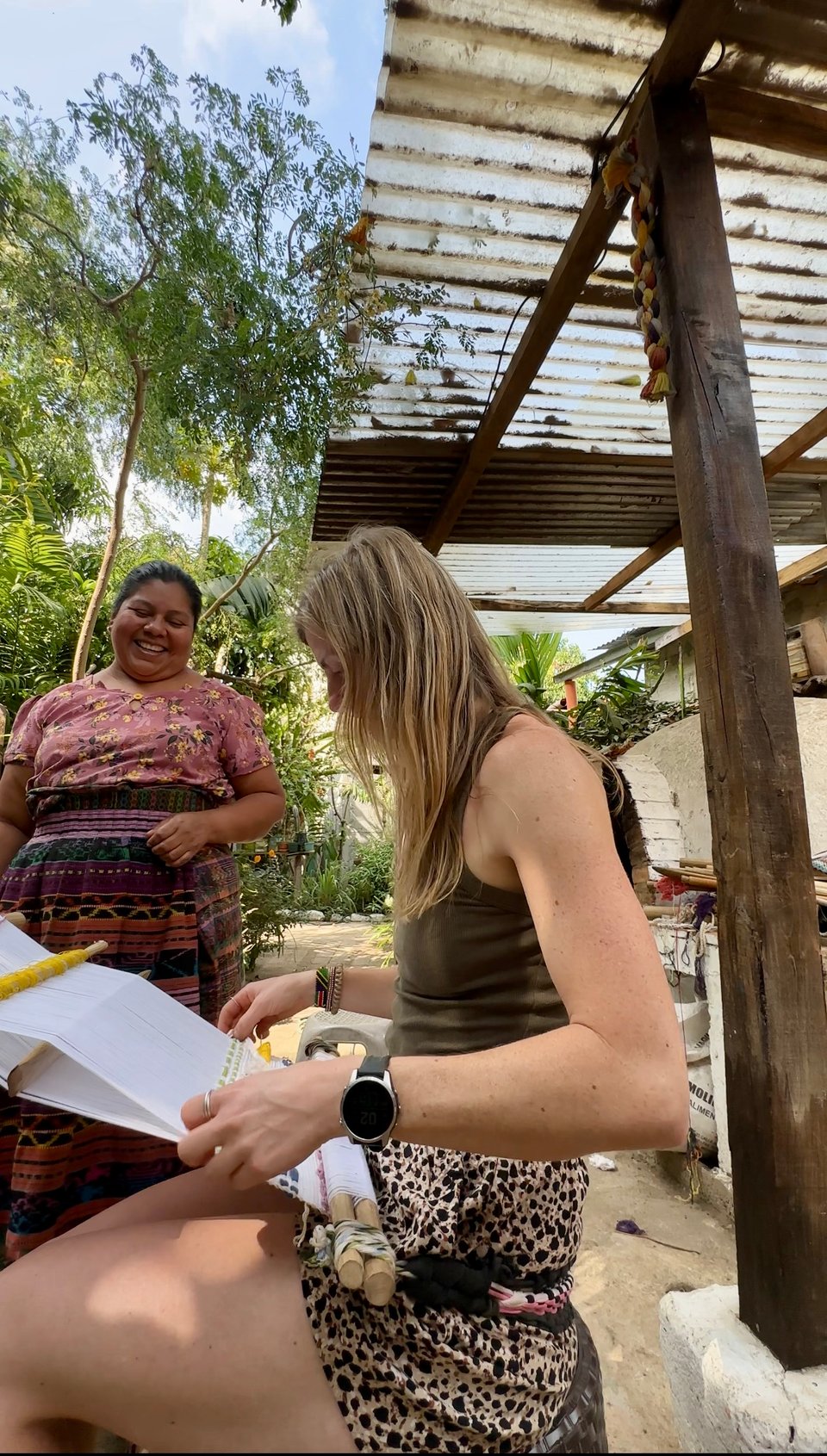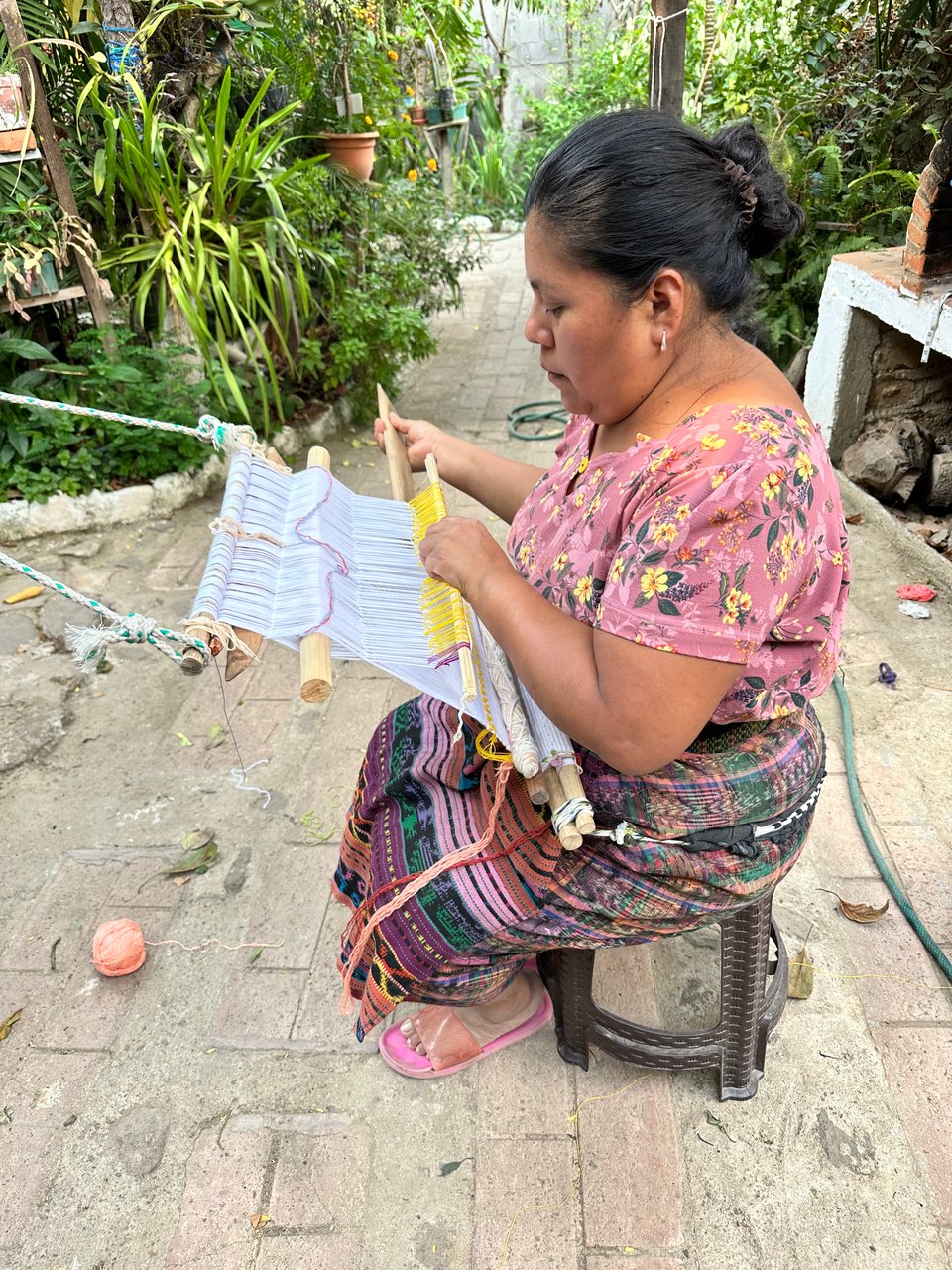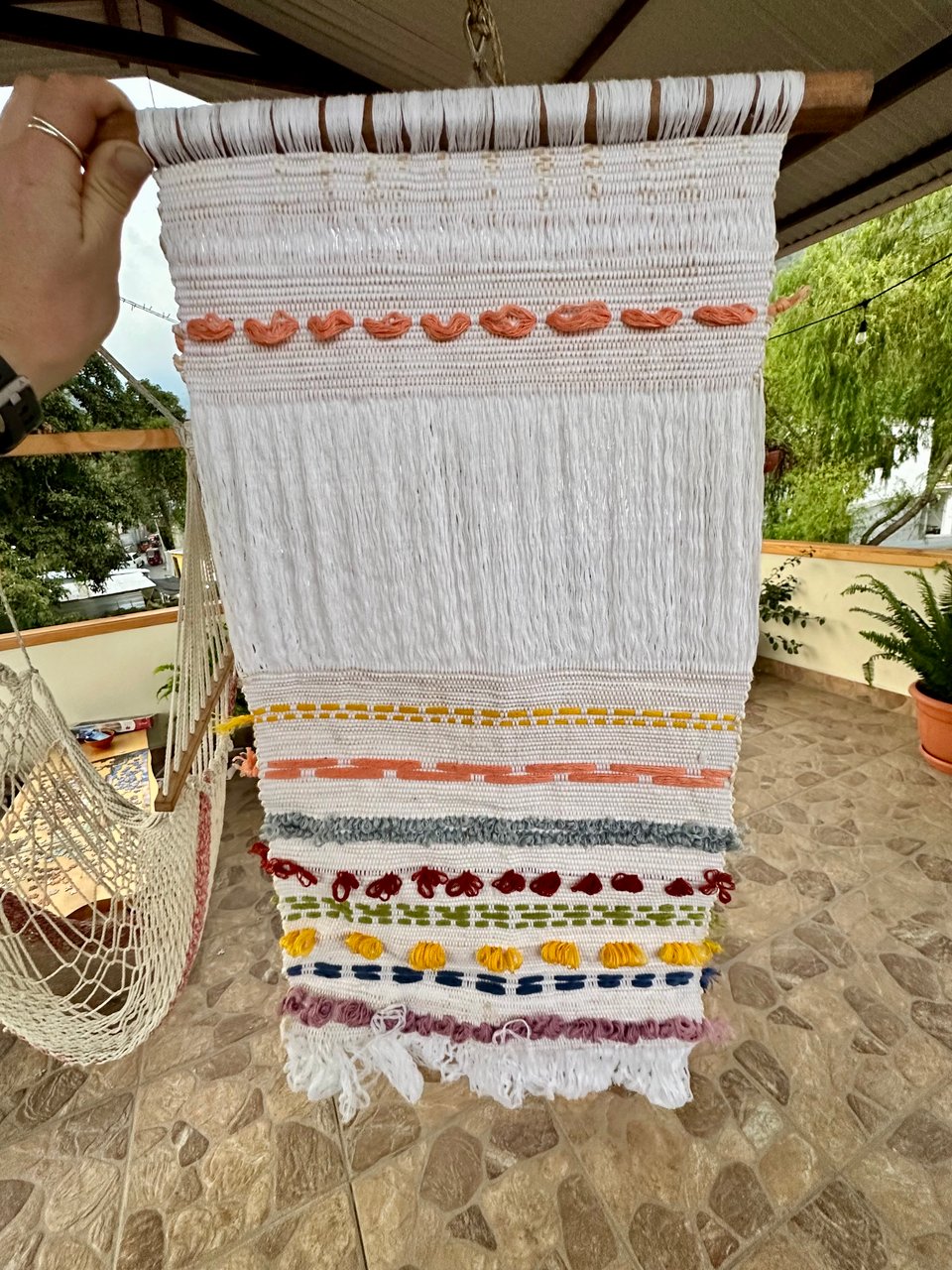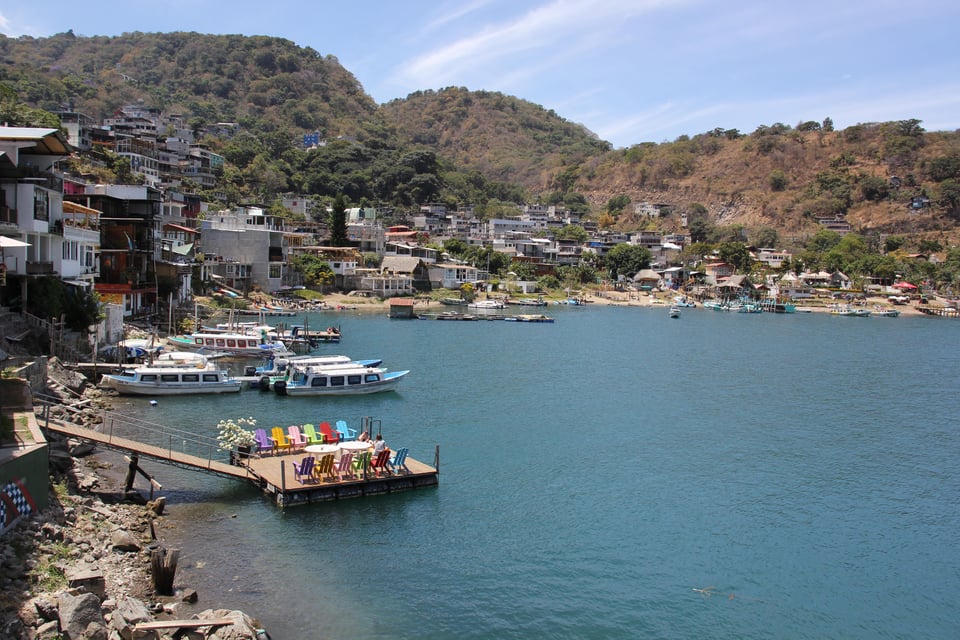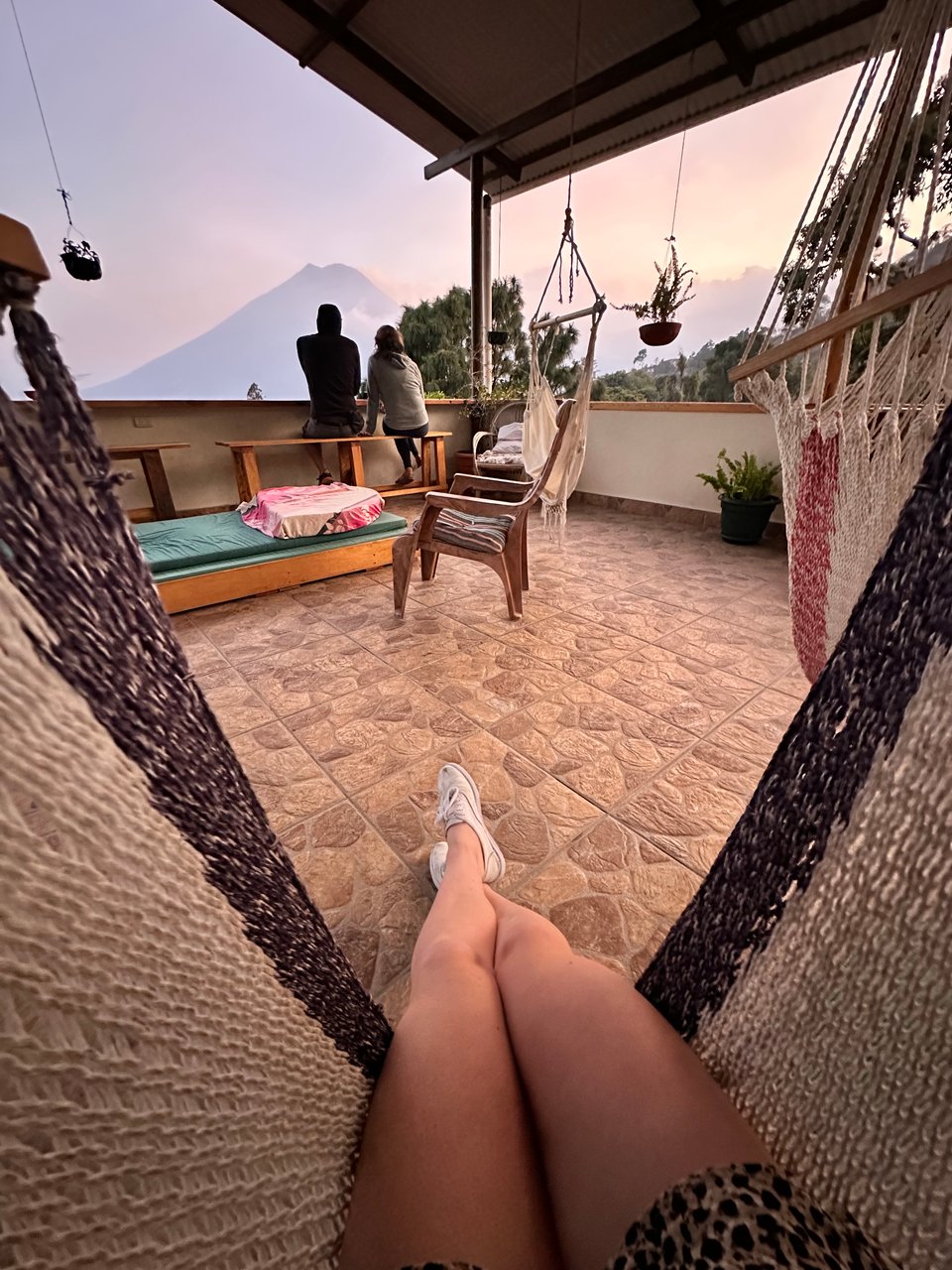Xela to Atitlan: Guatemala days 6-10
Get ready for a long one…
Before setting out to Guatemala I’d hoped to do two things: hike Acatenango volcano, which I’d planned for the end of my trip, and do a 3-day trek from Xela to Lake Atitlan, the destination everyone says one must go to.
I’d heard about the trek to Lake Atitlan from Matty, a Canadian I had met in Australia last year. Matty had worked for the company that runs the trek, Quetzaltrekkers and told me that they aligned heavily with my values as an outdoors woman and an educator.
This became quite clear during my night-before meeting with Quetzaltrekkers when they explained the origin of the company 30 years ago. Our guides, Nathan, Kim, and Quinn told us the story: Post-armed conflict in Guatemala, two teachers in Xela noticed a lot of primary school age children not in school. They worked tirelessly and tried many different efforts to raise money to put schools in these communities, eventually realizing there was money to be had in leading people through the more rural parts of Guatemala. So Quetzaltrekkers, the nonprofit, was born. We learned in the initial meeting, and throughout the trip, that all of the money we pay for the trek goes back into the communities somehow, either in the form of paying the families who’s homes we sleep in on route, spending in local markets to secure rations and meals, and supporting the schools and safe houses with the leftover funds.
After discussing the origin of the company and how it gives back, the guides gave us communal food to pack in our packs (I was charged with a bag of tostadas that I swore I’d keep in one piece, packets of tomato paste, and a container of trail mix), set us up with necessary gear, such as sleeping bags and pads, and reviewed the 3 day route with us; we’d be hiking 46km over 3 days, with most of the km in the first 2 days. Our group of 13, a mixture of singles and couples from all over the world, was full of energy and stoke for the days to come.
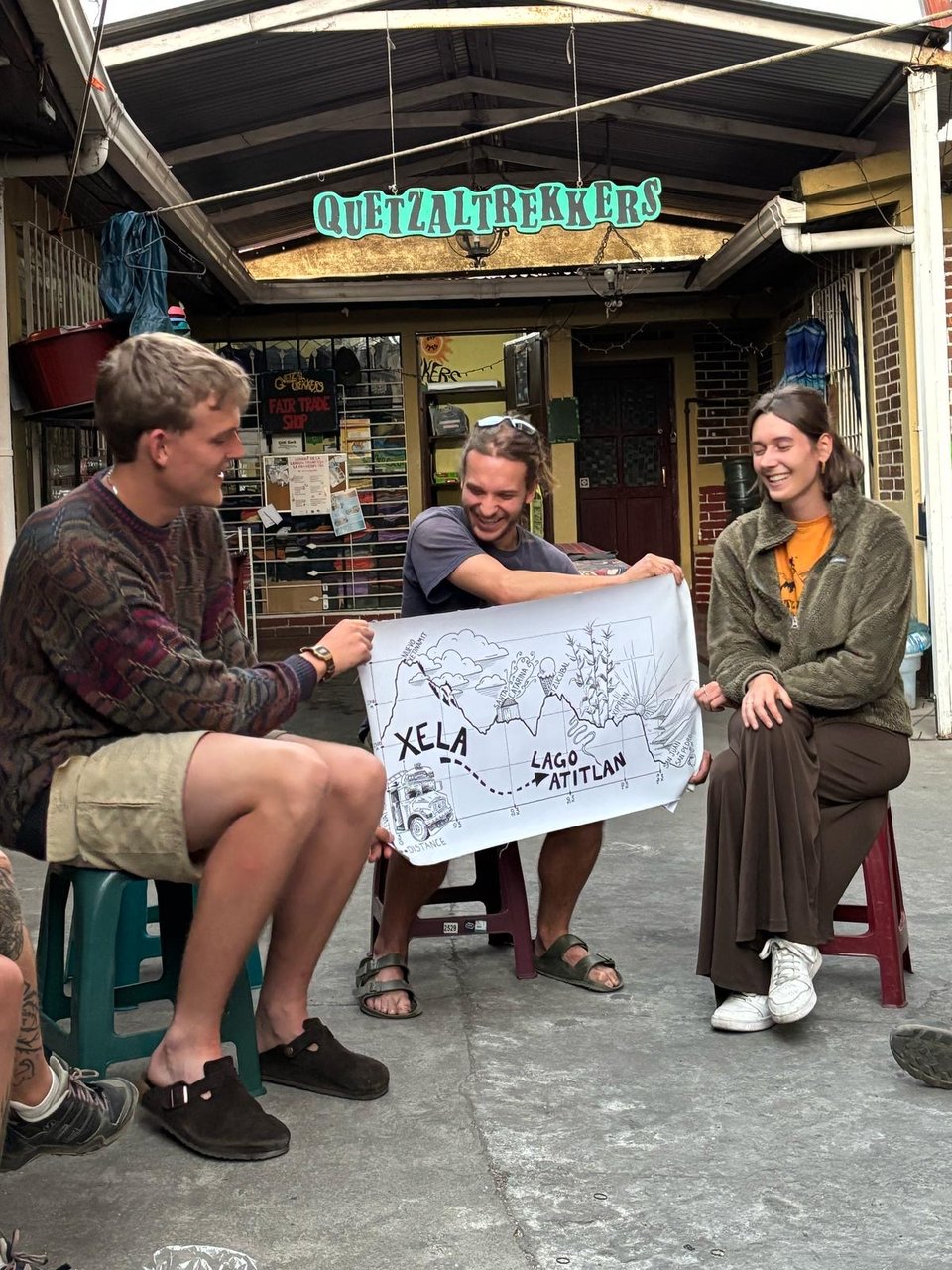
At 6 am the next morning we all convened at Quetzaltrekkers again for our first breakfast together and then the start of our journey. Our group happily munched on eggs, seasoned potatoes, and fruit while getting to know each other. At our places were additional containers of communal food, these more fresh than the ones from the day before. Mine said “bell pepper,” while other’s said “guac” or “tomatoes” and collectively we started to wonder what we’d be eating later.
Breakfast ended, and they showed us to how to use the pila to wash our dishes. These are sinks most commonly used in more rural parts of Guatemala. They consist of 3 basins, the middle one has a spigot and is usually filled with water. One uses a bowl to take water from the middle and wash or rinse dishes, clothes, etc that are in the two, much more shallow, side basins.
While washing, the only other American in our group, a guy named Ariel, and I talked about how hard it was to remember everyone’s name, and how heartbroken he was over the lack of cringy ice breaker games to get to know each other. Done with washing and joking, we put our packs on and our group followed Kim a few kilometers through town to catch a chicken bus to the trailhead. We were quite a sight, 16 obviously-not-locals gallivanting through the city streets with massive backpacking packs on, poles and foam sleeping pads sticking out every which way.
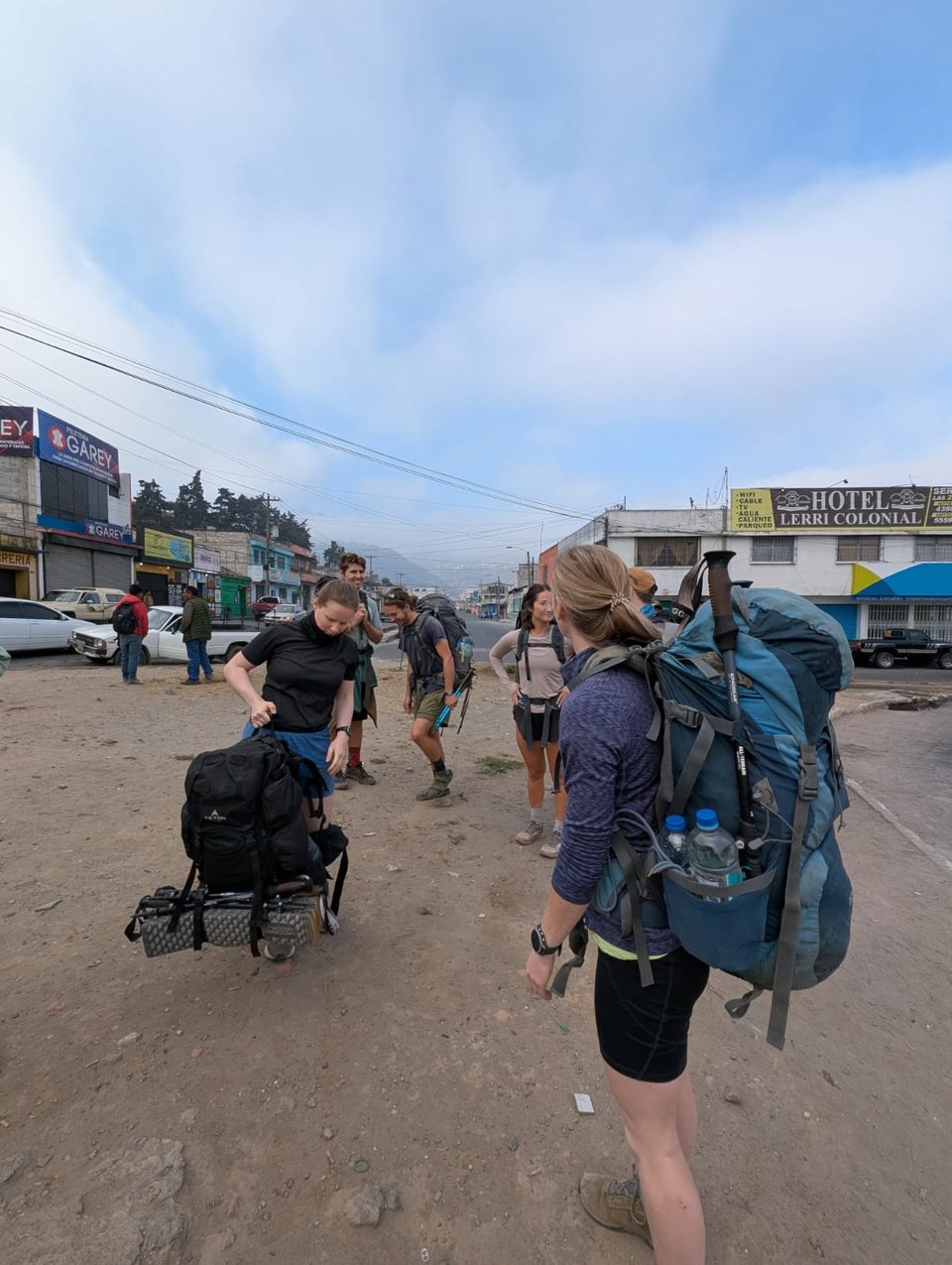
We piled into a chicken bus, rode for 15 or so minutes up the hill and got dropped off at the edge of civilization. Let the long walk begin!
But wait, 10 minutes up the hill our guides stopped us and much to Ariel’s delight we played an ice breaker. Each person had to say their name and a word that started with the same letter, but before saying your own word and name you had to say everyone else’s that had gone before you. By the time it got to me we’d done quick Quinn, mature Nathan, kimchi Kim, alligator Achilles, Gracious Gaelle, crazy Claude, Rabbit Rebecca, and mindful Marike. I felt for the people at the end who had to do all 16 names…
Once we’d had each other’s names repeatedly and comically nonsensed into our memory the trek actually began. We journeyed up through cloud forest and eventually out into the open agricultural fields and beat down by the harsh sun. We took breaks every hour or so, and occasionally had bits of information about Guatemalan history or folklore presented to us by the guides on these small breaks. The first took us by surprise, as Quinn and Kim acted out the battle between Spanish conquistador,Pedro de Alvarado, and Quiche Mayan warrior, Tecún Umàn. Umàn (Quinn) shot Alvarado’s horse thinking that the man and horse were one being, which took Alvarado (Kim) to the ground. Alvarado fired his gun, hitting Umàn. As he bled out, the sacred quetzal, who was his spirit connection to nature, flew and landed on his wound. That is how the quetzal is said to have gotten his red chest. Both guides after their reenactment were covered in dirt, but their commitment to the story really made it stick.
After the open agricultural fields was yet another surprise! This was the best one, by far. We took a long break and those of us with trail mix got to take it out for munch time. Ravenous, we got some poured into our dusty hands and took our first pieces into our mouths. Across the group you heard exclamation after exclamation, “holy moly..” and “oh my goodness, this is heaven” among groans of contentment. That trail mix became the thing everyone looked forward to; quetzaltrekkers seems to know they’ve mastered their recipe, because it was even available for purchase after we finished on day 3. It was that good…
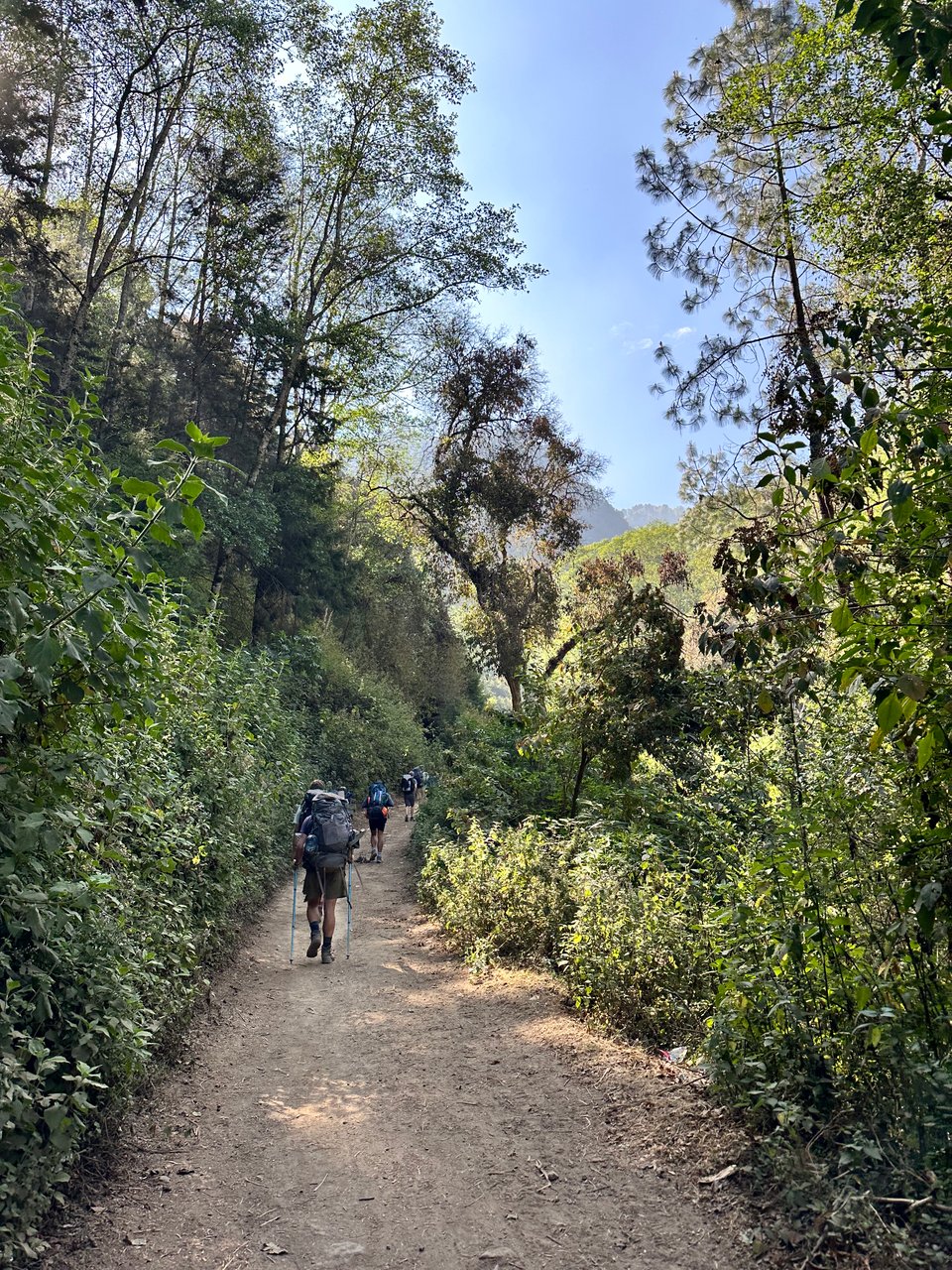
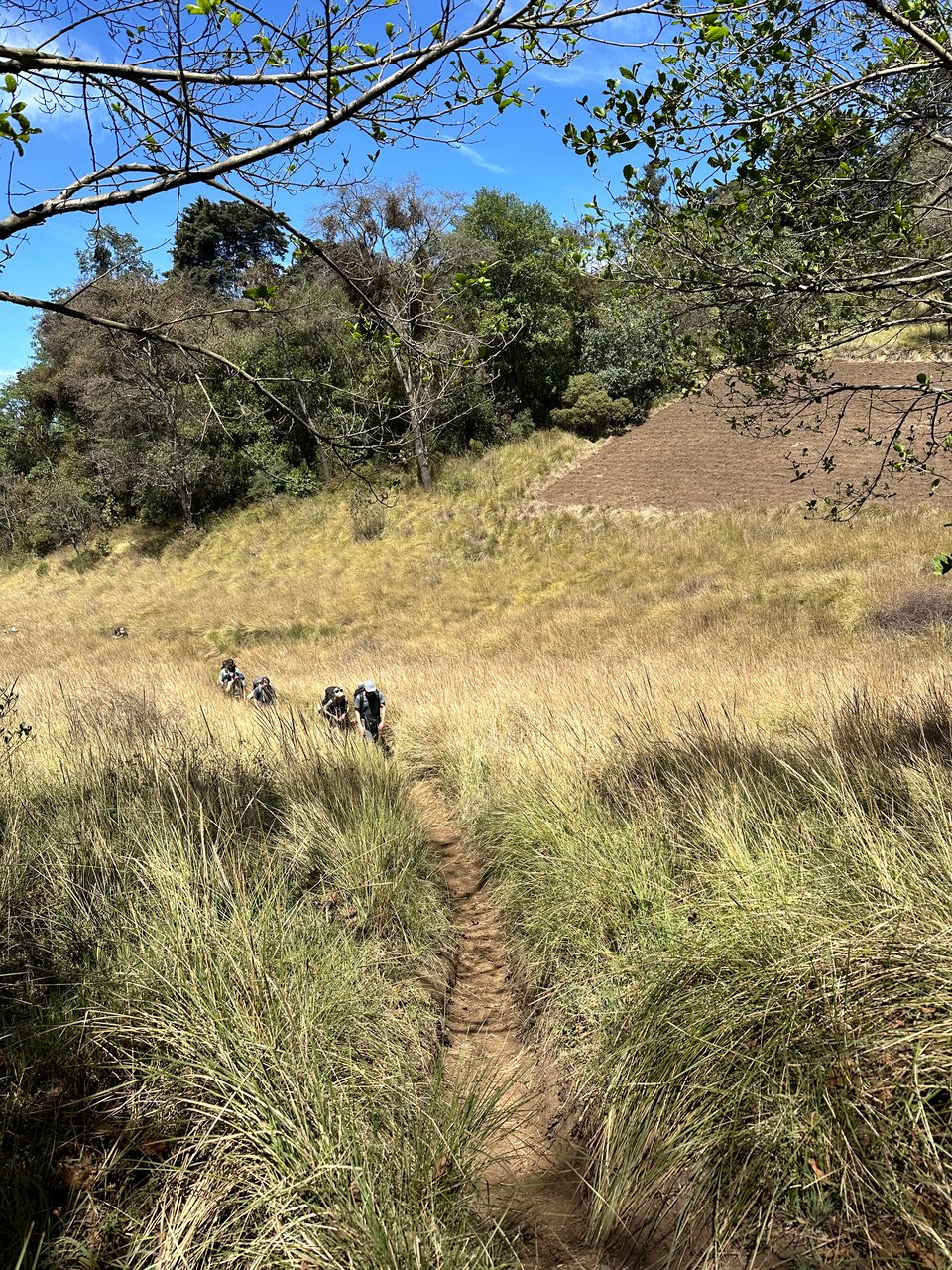
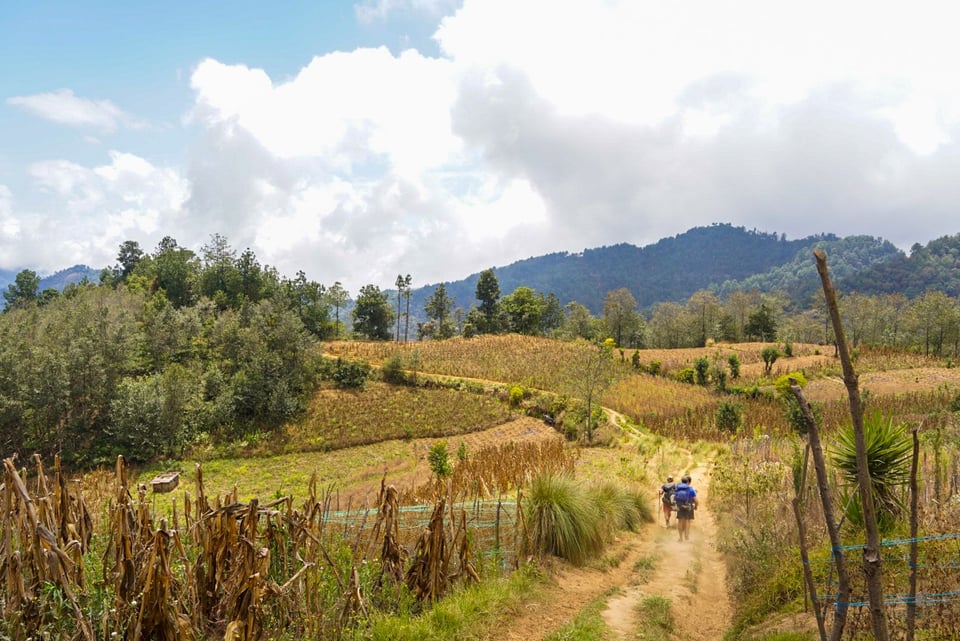
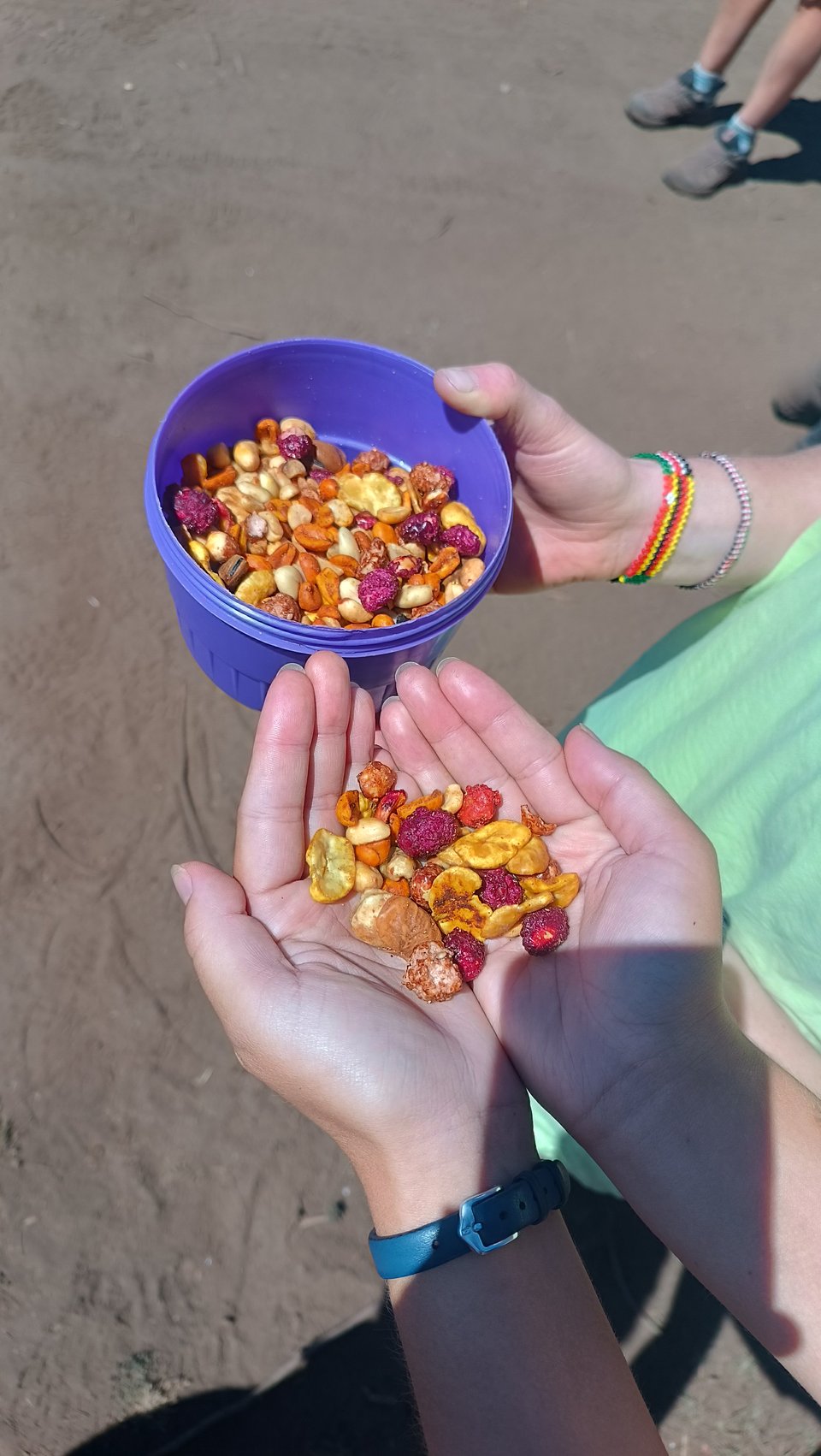
The semi-frequent breaks were welcomed not just because of the heat, but also because the group reconfigured a little each time and we got to chat with new people and get to know them better.
I’d been chatting with Achilles, a French man, for most of the morning about our sports and hobbies and after the trail mix break got to cheating with Meg, a British gal. She was my buddy until the first real vista we got on the trip. It overlooked a valley and few of the many volcanos in Guatemala! The trail up to it is primarily used by locals to journey between towns. We saw no one else; How amazing it was to be out in the highlands on roads less traveled, seeing views that so few get. Not long after the viewpoint was lunch, which was yet another delightful surprise! We were asked to get out all of the fresh foods we’d been carrying, and the guides laid them out on a tarp. We were having tostadas with all of the fixings! And I mean ALL of them, or so it seemed. I’ve never had such a glamorous lunch in the middle of absolutely nowhere.
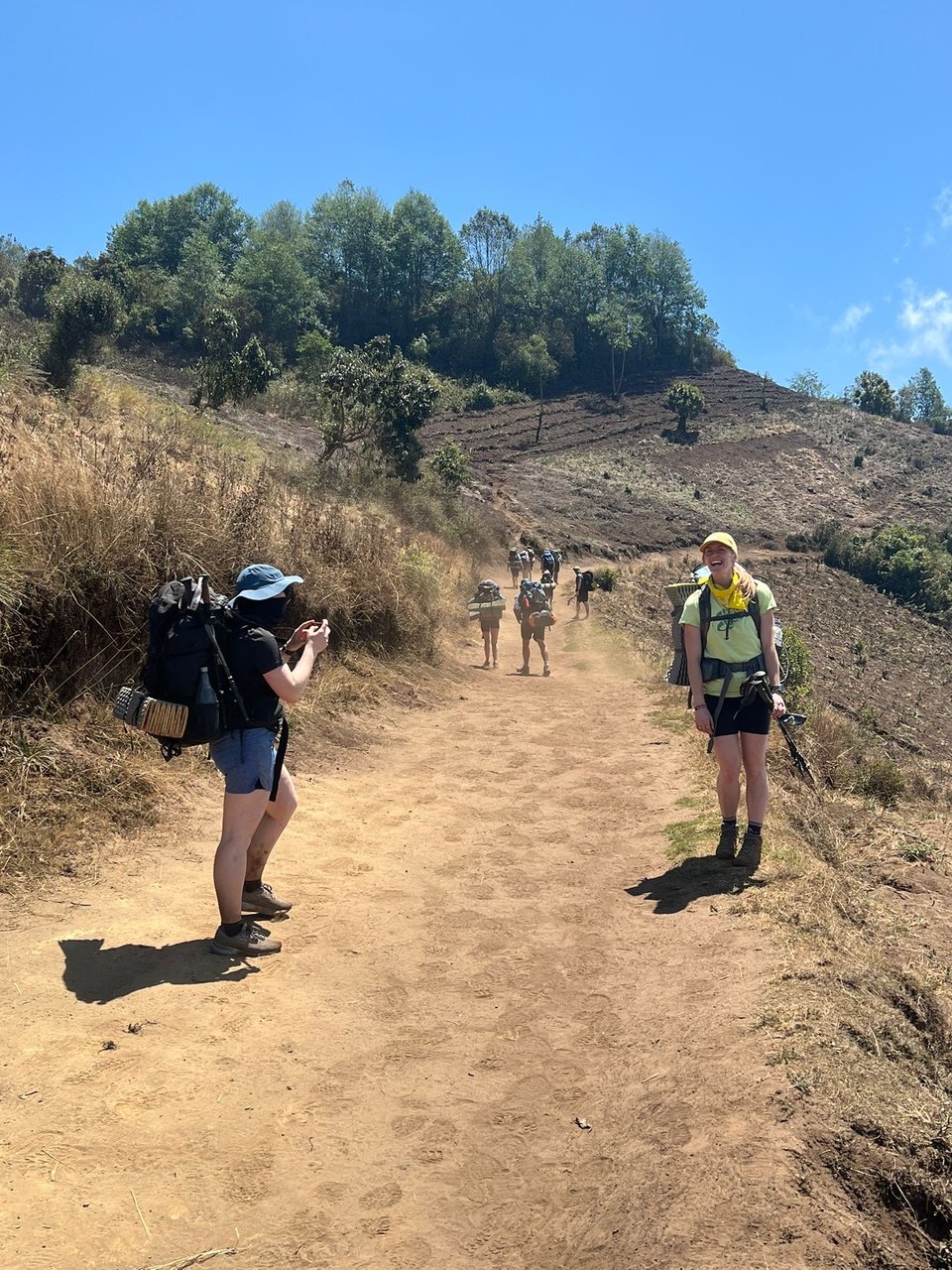

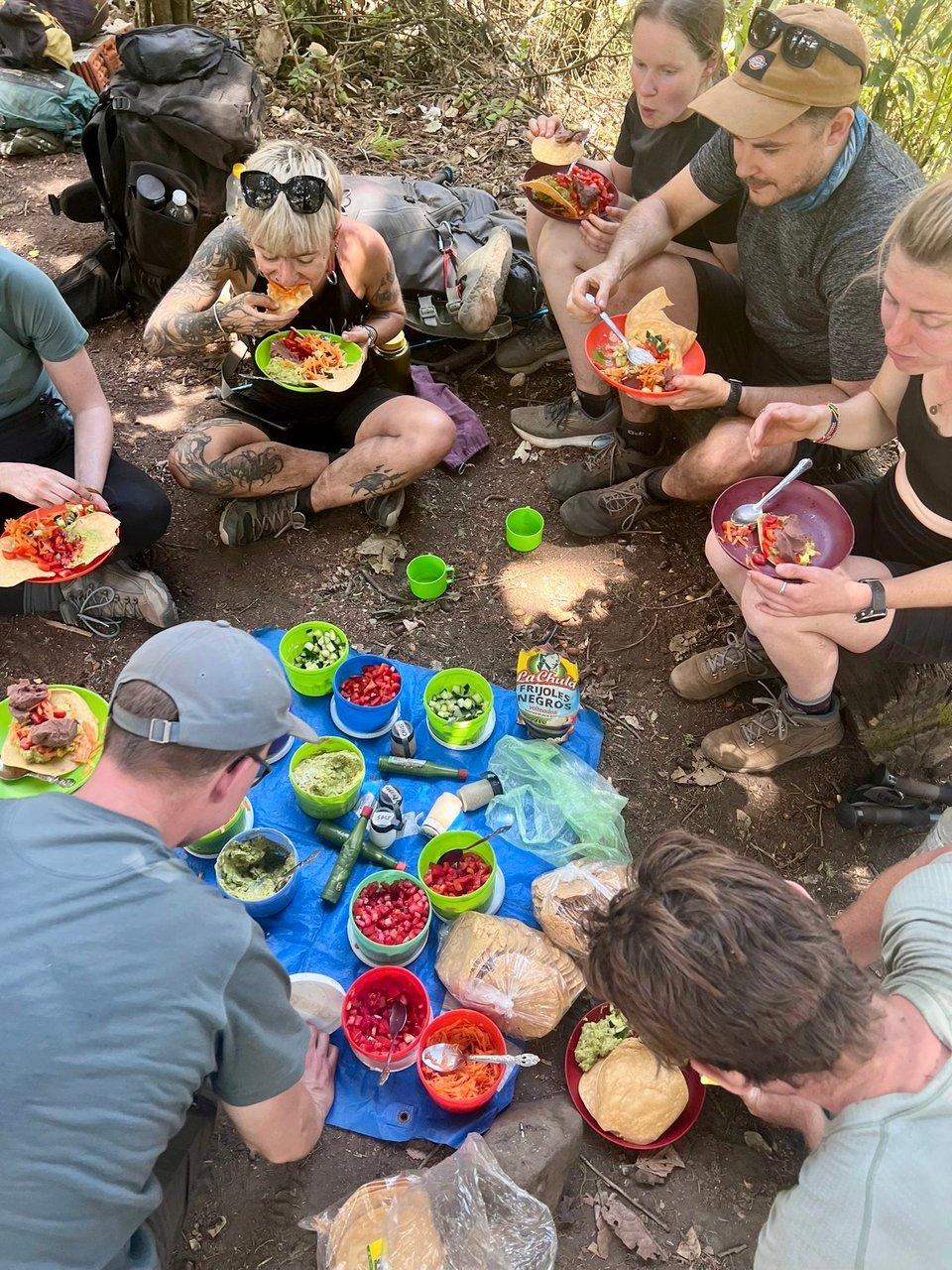

The remainder of our day was down through more cloud forest where Quinn showed us his favorite trees; they were covered in massive air plants, which he explained weren’t parasitic but instead lived in symbiosis with the trees. After just over 10 miles, we made it into Santa Catarina and our home stay at Don Francisco’s house. We got snacks and drinks at one of the town’s two tiendas, and hung out until it was our turn for a Guatemalan temescal. A temescal is a Mesoamerican “sweat house” or sauna. Usually it is used for ceremonies and healing, but can also be used for bathing and purifying. Marieke, a Dutch girl I’d say next to on the bus, and I were partnered and spent our 30 minute session in the tiny concrete house with a rusty metal door soaking in the heat, bathing with the deliciously hot water, and getting deep.
Once purified and cleansed, we wandered back to the home stay to lay out our beds and eat dinner. I’m not sure what I’d expected of the home stay sleeping arrangement, but it was not what we were met with. We were given bamboo mats, told to choose a spot on the concrete floor in a large room, and then placed our foam pads and sleeping bags on top of the bamboo mat. It was reminiscent of sleepovers as a kid, but with a bit more “roughing it” to it.
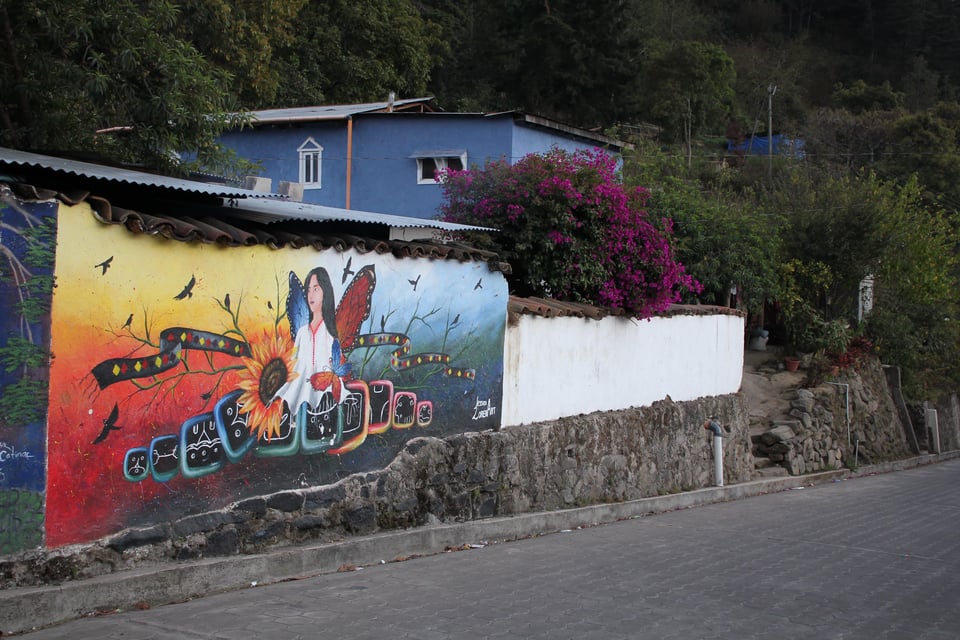
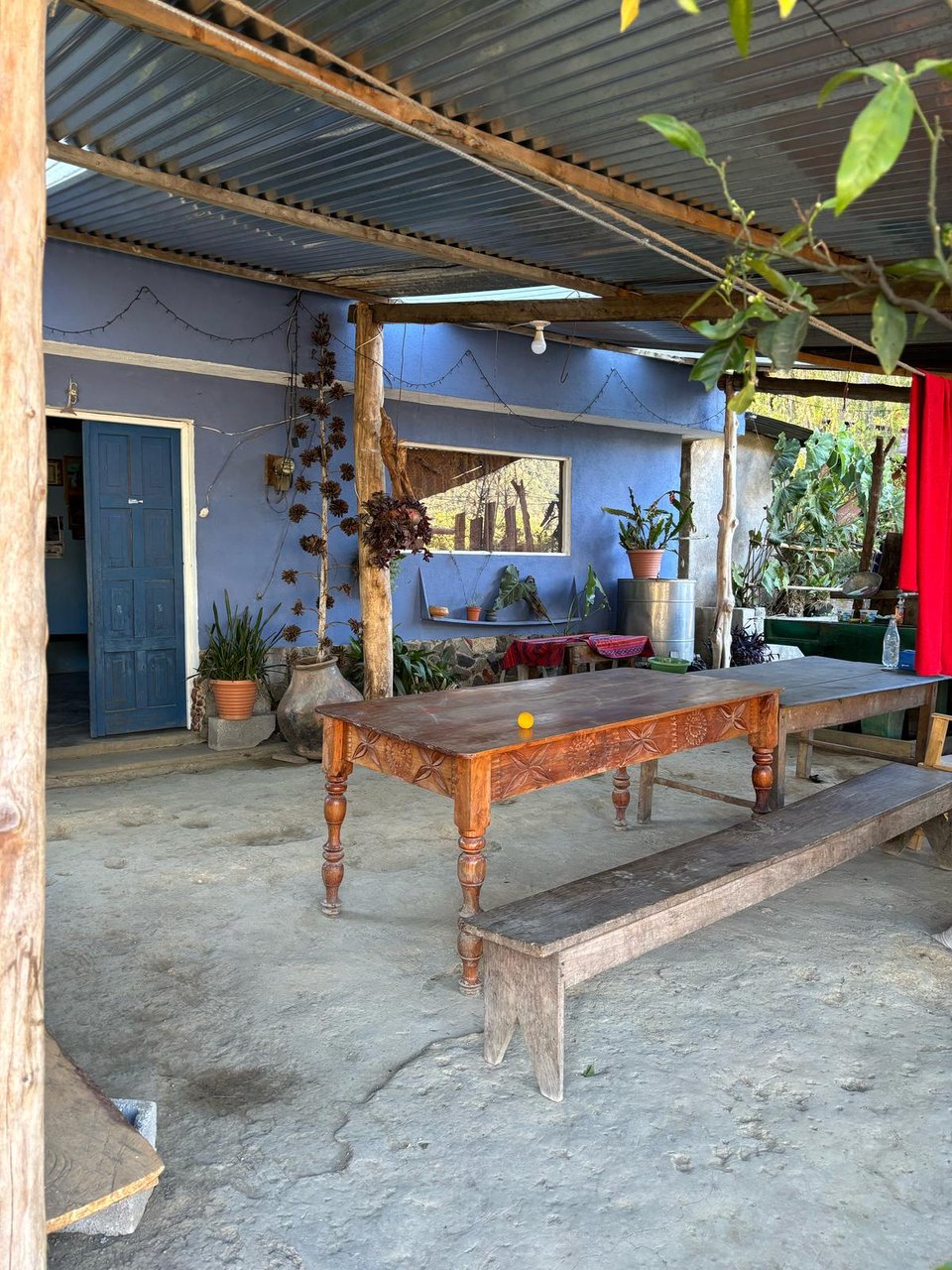
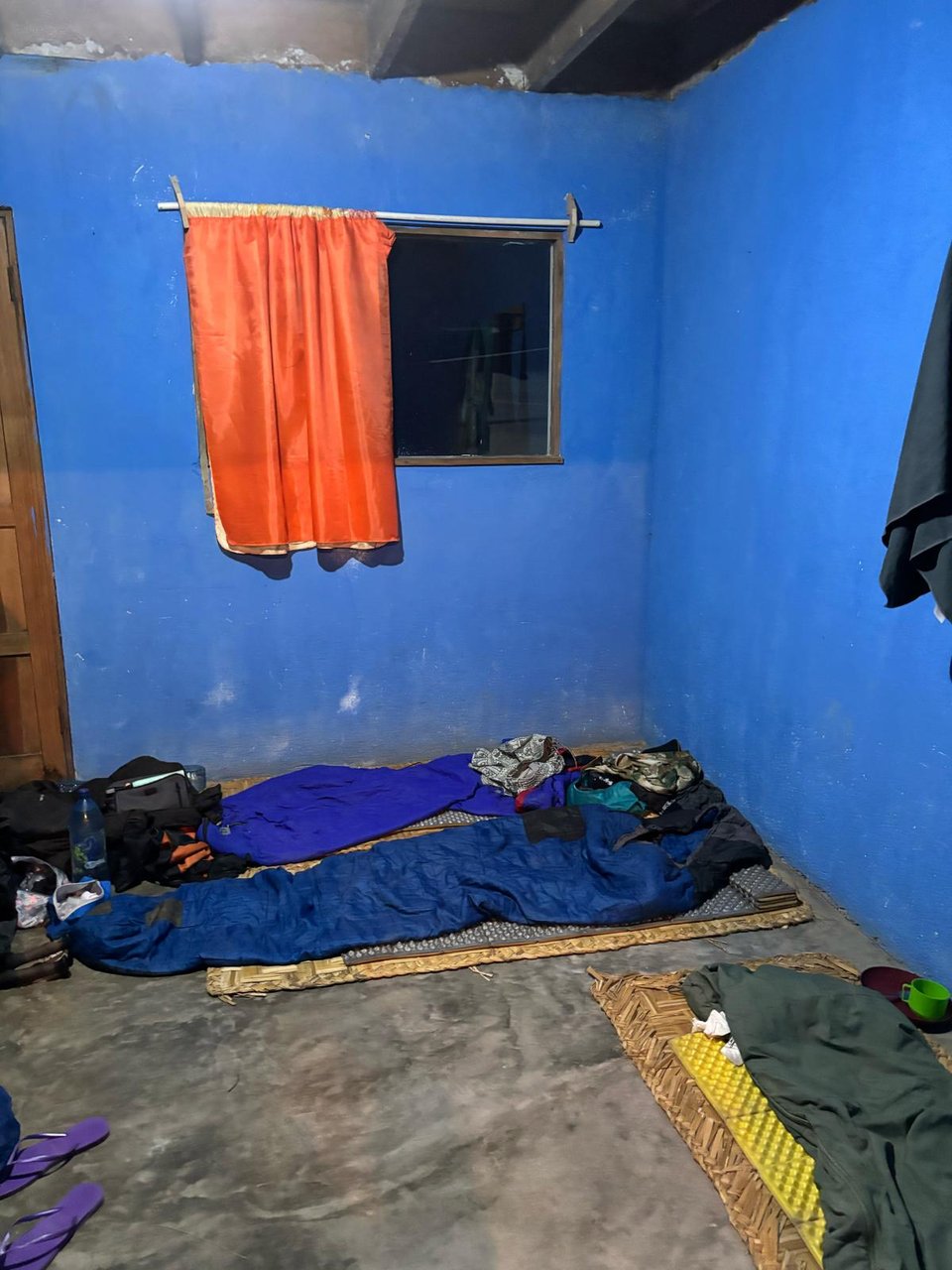
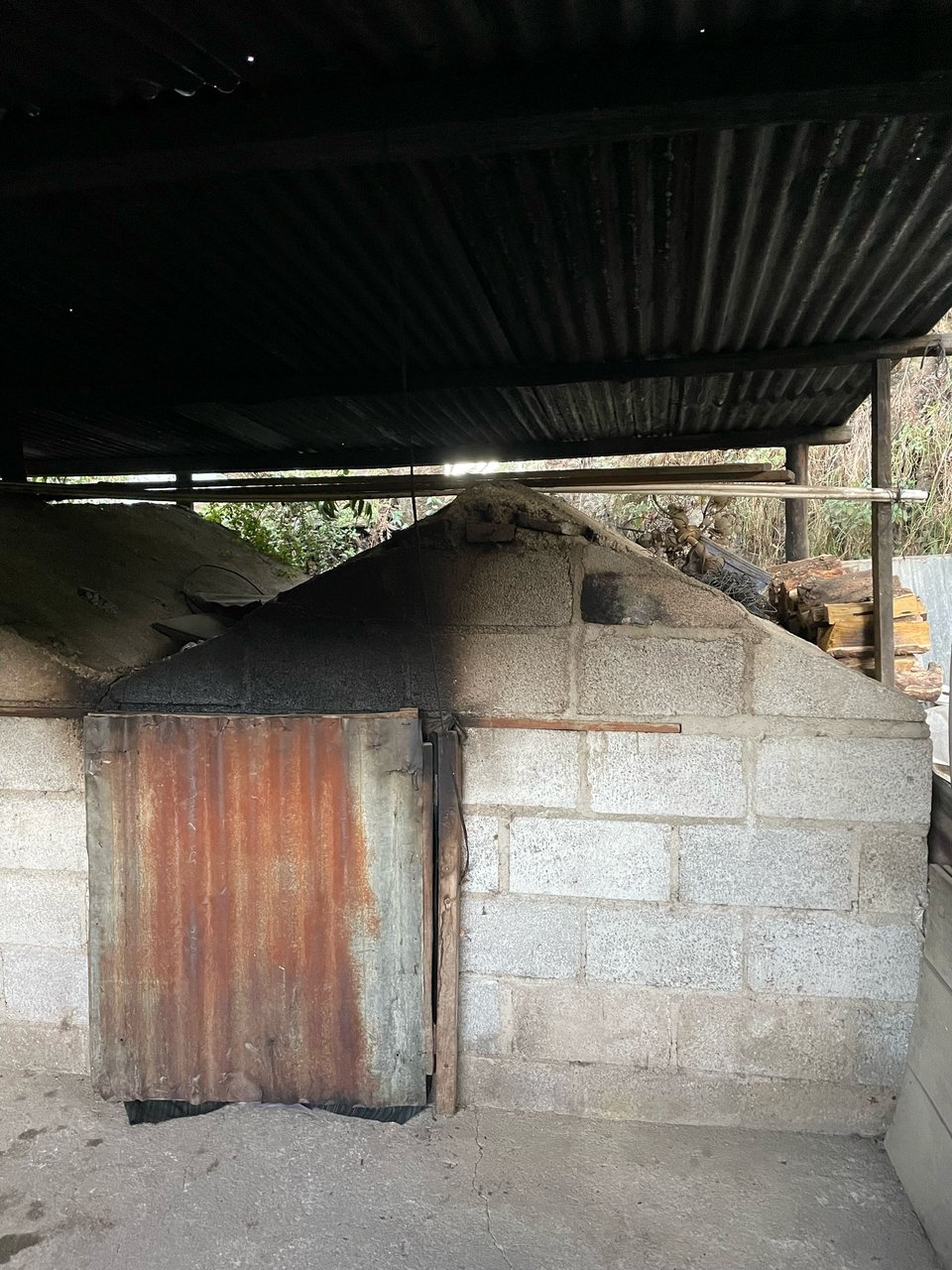
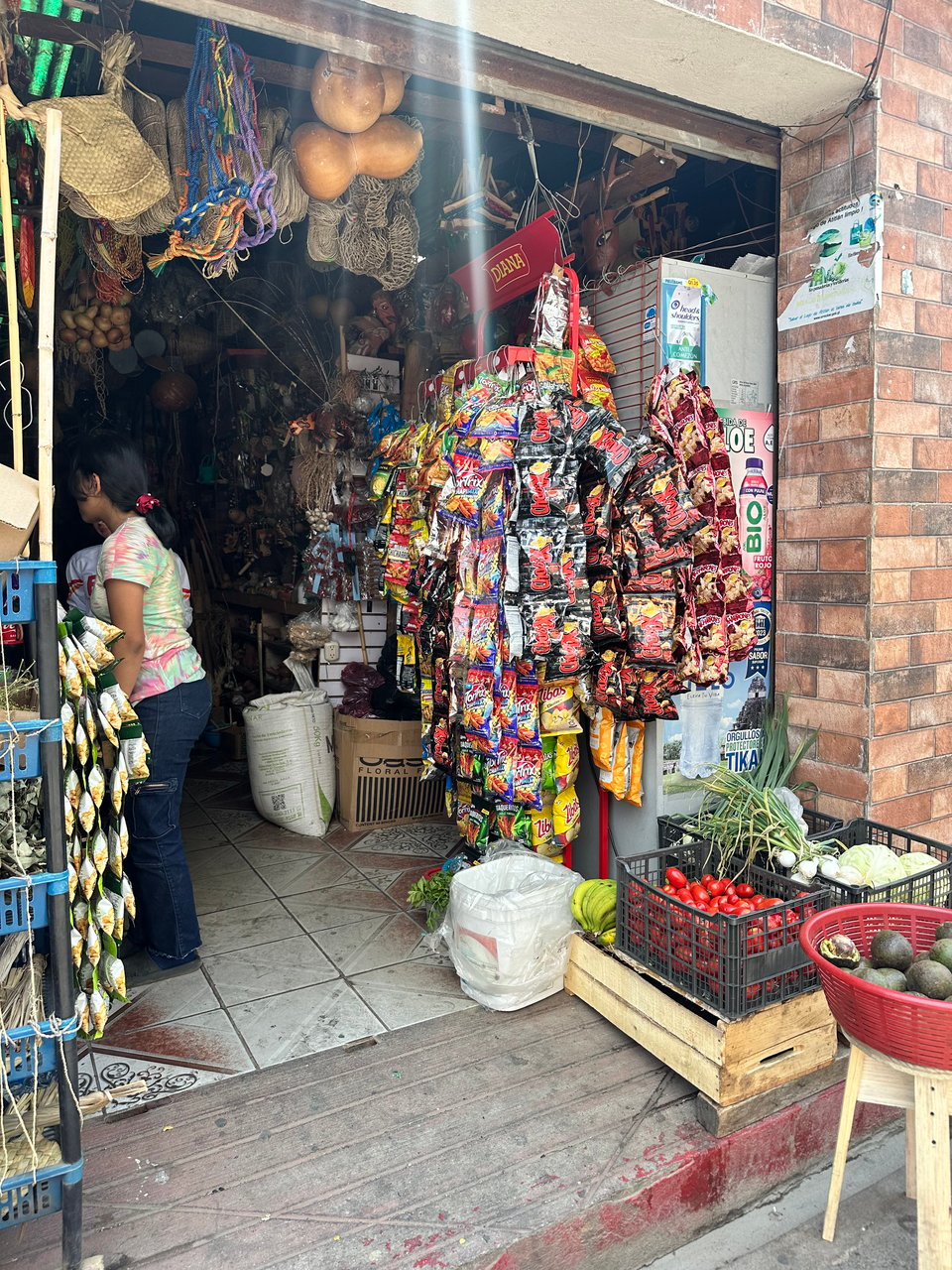
After a pasta dinner, we all crawled into bed. My stomach was real unhappy and my gas was out of the control- I attributed it to the beans we’d had for lunch and snuggled in for the night. Joke was on me…
Within 15 minutes of laying down it became quite clear that my stomach cramping, gas, and nausea were not bean related. I made my way through the dark of the home stay to the bathrooms that were outside, and found my body to be revolting against me.
I’d been intelligent enough to buy Imodium before this trip after my illness experience in Peru, so I took the prescribed first dose of two pills and tried to go back to sleep. I woke up every hour and a half or so with a new wave of cramping and nausea and urgency- making my way to the bathroom in the dark again and again but usually with no result. At 4 am I finally managed to get something out of my body and hoped that was it. But at 6 am wake up, I was still miserable so I communicated with the guides, took one more Imodium, and hoped I could get through the day. I’d evaluate along the way, and get transport to the next home stay if needed. My roommates, Achilles, Gaelle, Sam, and Meg were total gems, getting me extra meds and playing parents to me. It was the sweetest and was a great reminder of how wonderful people are regardless of how well you know them.
I managed some breakfast and we set out. It was an easy morning and I felt ok- walking seemed to be helping. I made it to Quetzaltrekkers’ “selfie rock” where we took a silly group photo, and soon after we hit “ice cream mountain” which was meant to be one of two difficult sections in the day. Nathan had said if I started the ascent I had to finish it, and I felt good so I went for it. It was blistering hot, again and the ascent after little sleep and being ill got me. We got to the town where there was yet another tienda (they’re everywhere!) and the promise of ice cream, but I was done. Continuing on would be of detriment to me, I could tell. We made our way through the town, which was the nicest I had seen so far. It turns out this is because that town has many families with family members in the States who send back remittances. You can really see the money in the much more lavish buildings, the well paved roads, and by the construction everywhere you look. Kim spoke of this during her informational speech on the topic of life in Guatemala and the process of being the family member trying to immigrate. As she spoke about the harrowing journey through Mexico and then across the US border with the help of coyotes, my heart hurt. I was already familiar with this process, it’s expense, and its danger from engaging with my students on the topic, but walking through and sitting in communities that are directly benefiting from others making such a brave, uncertain, and potentially sacrificial journey had a very different emotional tug to it. The unfairness of the US immigration system was at the forefront of my thoughts as I wrestled with the fact that any individual should have to put themselves through so much just to have the potential to give their families a better life. The place of privilege I was coming from has not often felt as clear as it did then.
When the somber mood at the tienda lifted a little, I informed the guides of my lack of desire to keep pushing myself and they understood. They called me a tuktuk and Nathan and I had our own, unique adventure to the next home stay while the rest of the gang went through the VERY dusty “cornfields of friendship” and did seven river crossings.
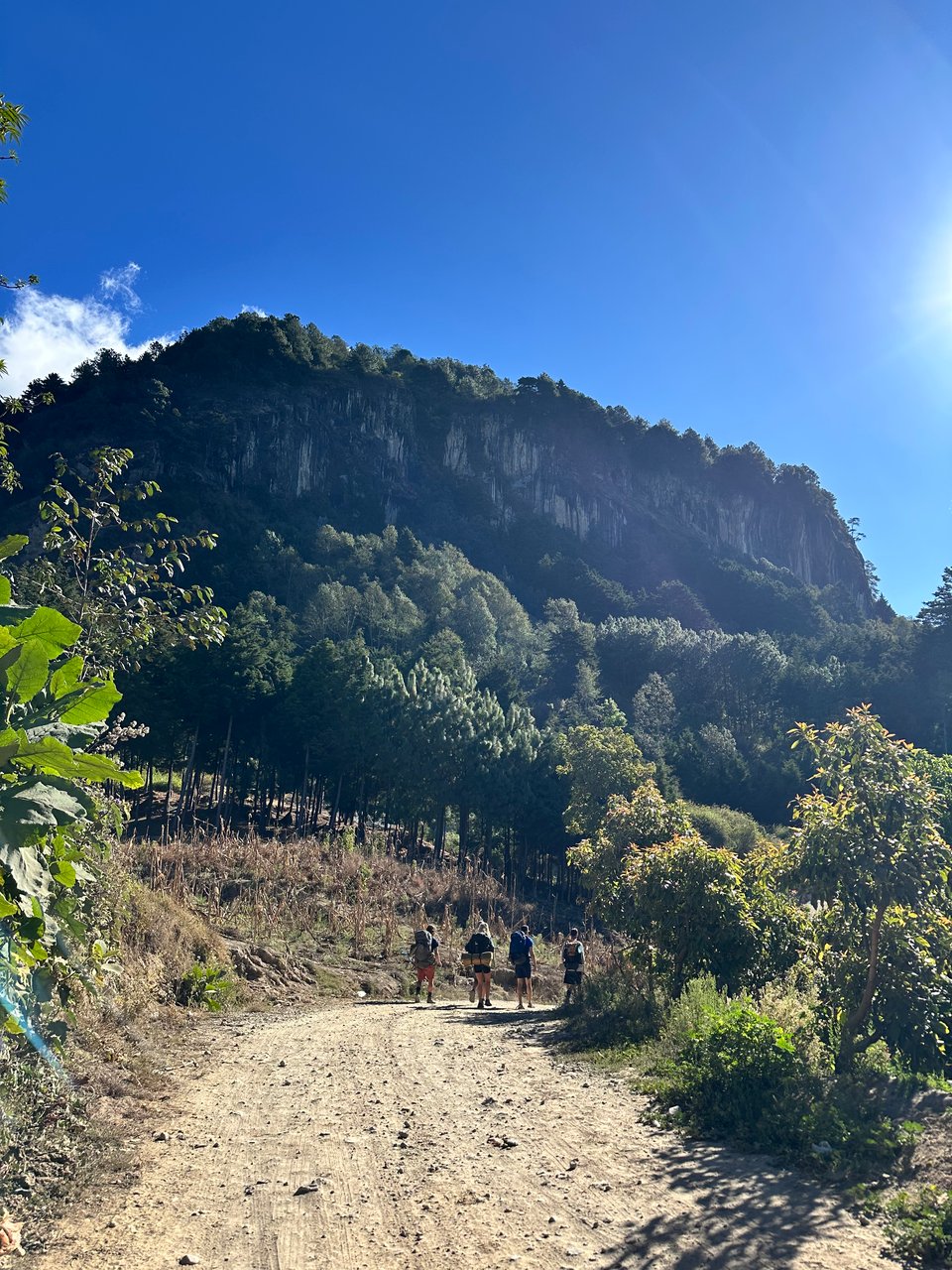
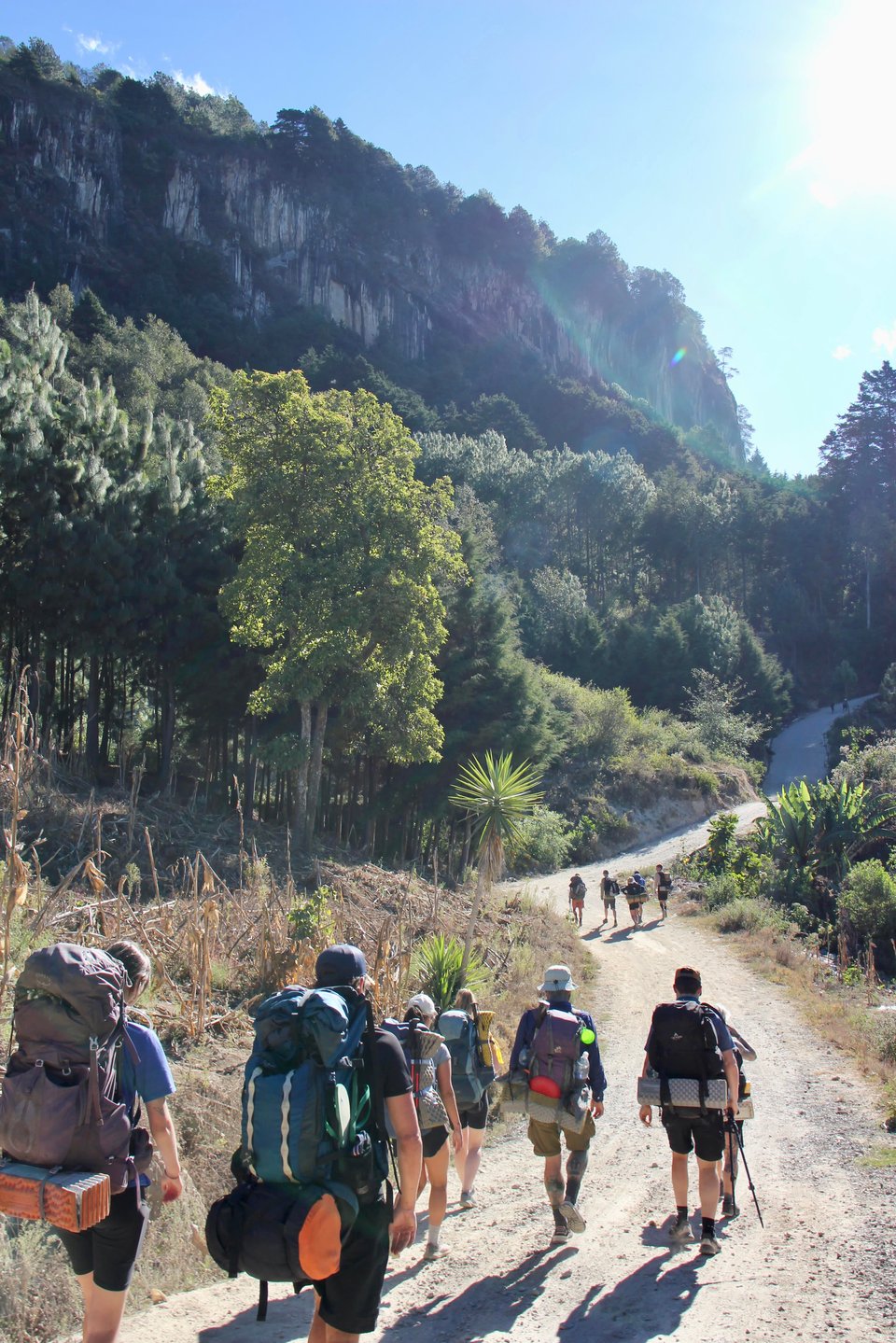
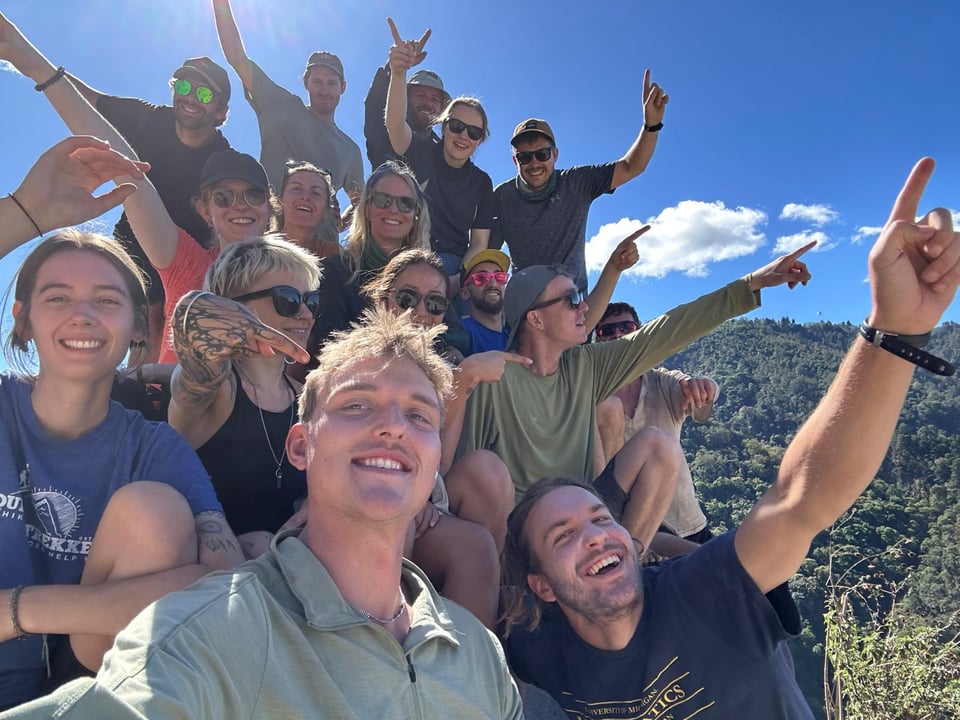
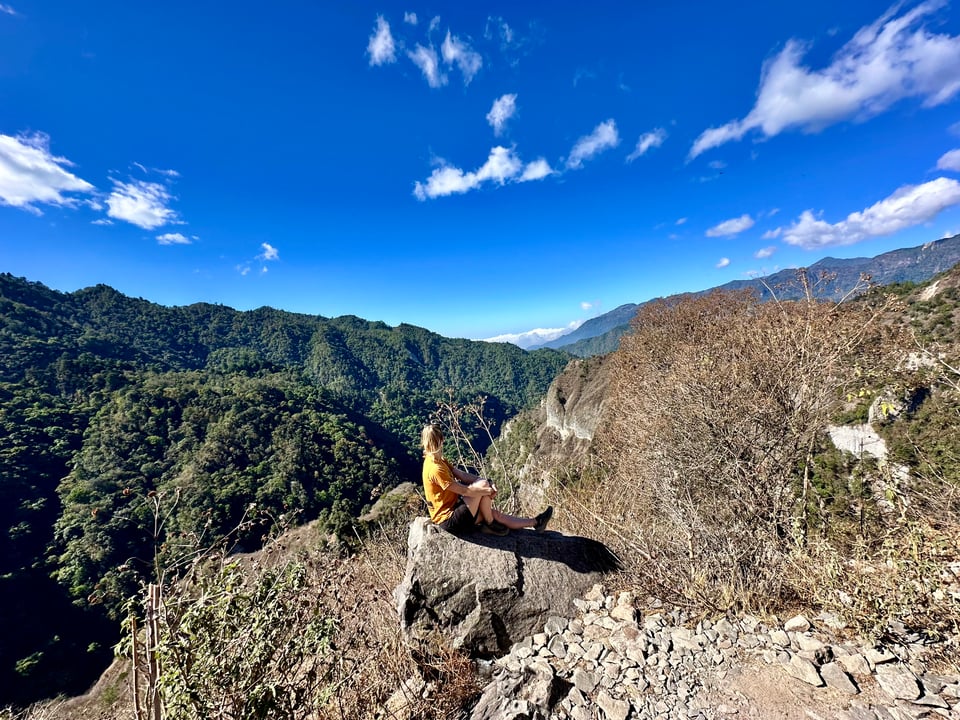
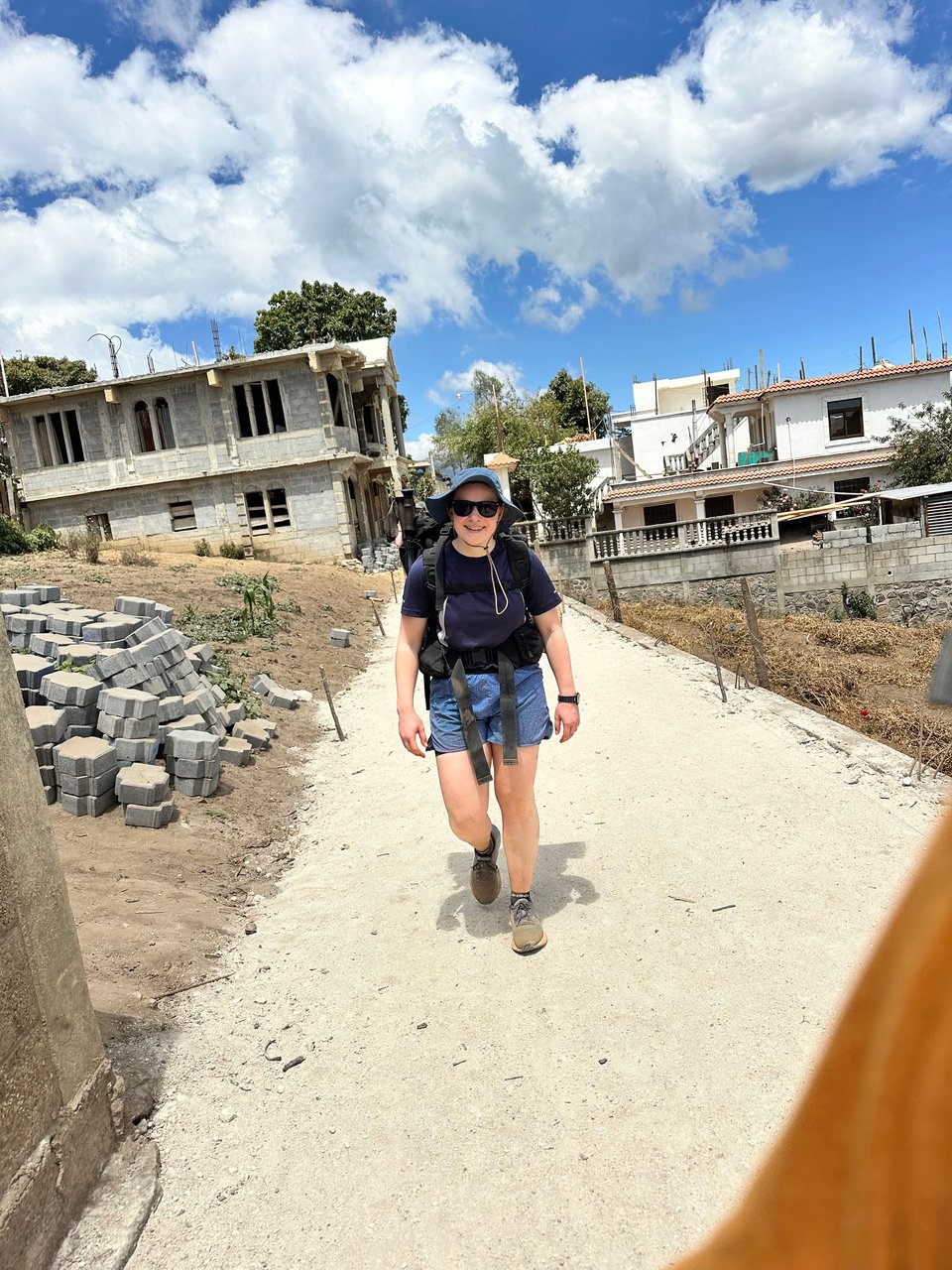
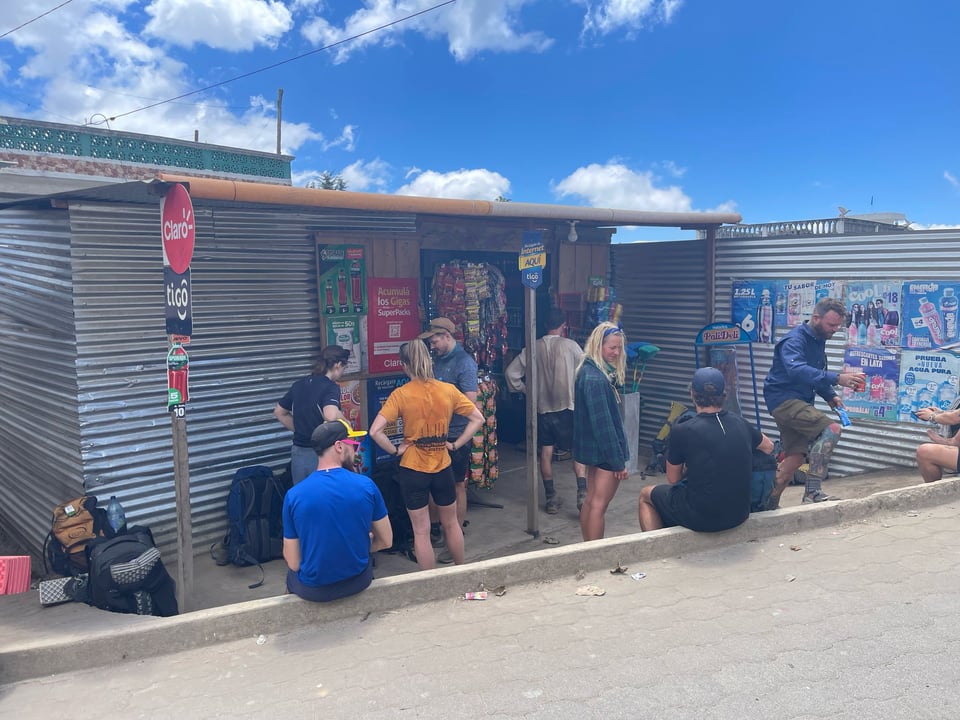
Once in Xiprian, at Don Pedro’s house Nathan let me know that the amount of Imodium I had taken was likely going to keep everything that was making me feel bad in my body.. great. They set me up on the floor again and I passed out for a few hours, waking up just in time to shower before the others got there. I managed down some rice, but was really not feeling stellar- I’d definitely pushed it.
We had a great evenings all together, playing games, watching the sunset from a rooftop terrace, and feasting. Well, everyone else feasted. I picked at some mashed potatoes and chicken, barely able to eat because of how bloated and nauseous I felt. Dinner was followed by a surprise of a fire and s’mores! Well, the closest thing they could get to a s’more here: chocolate sandwich cookies people pulled apart with a roasted, colored marshmallow between.

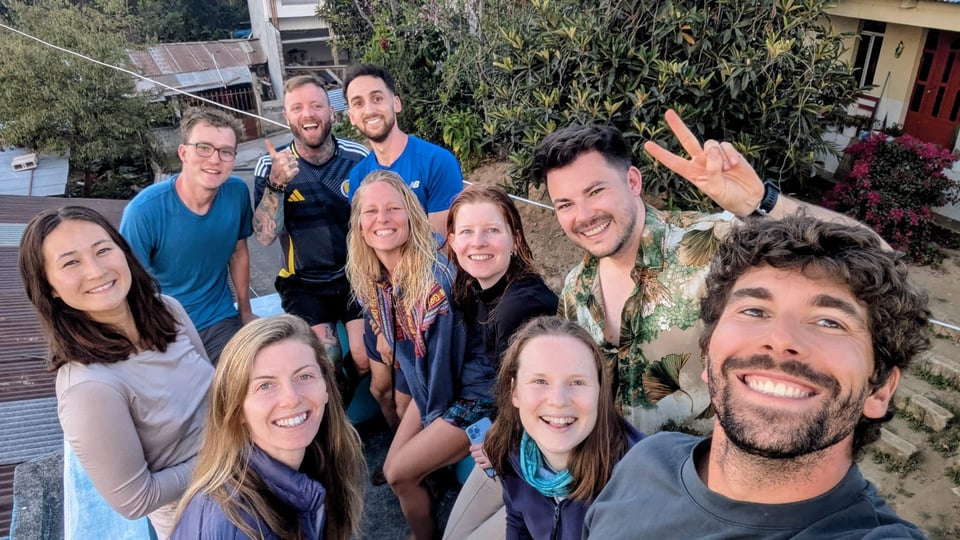

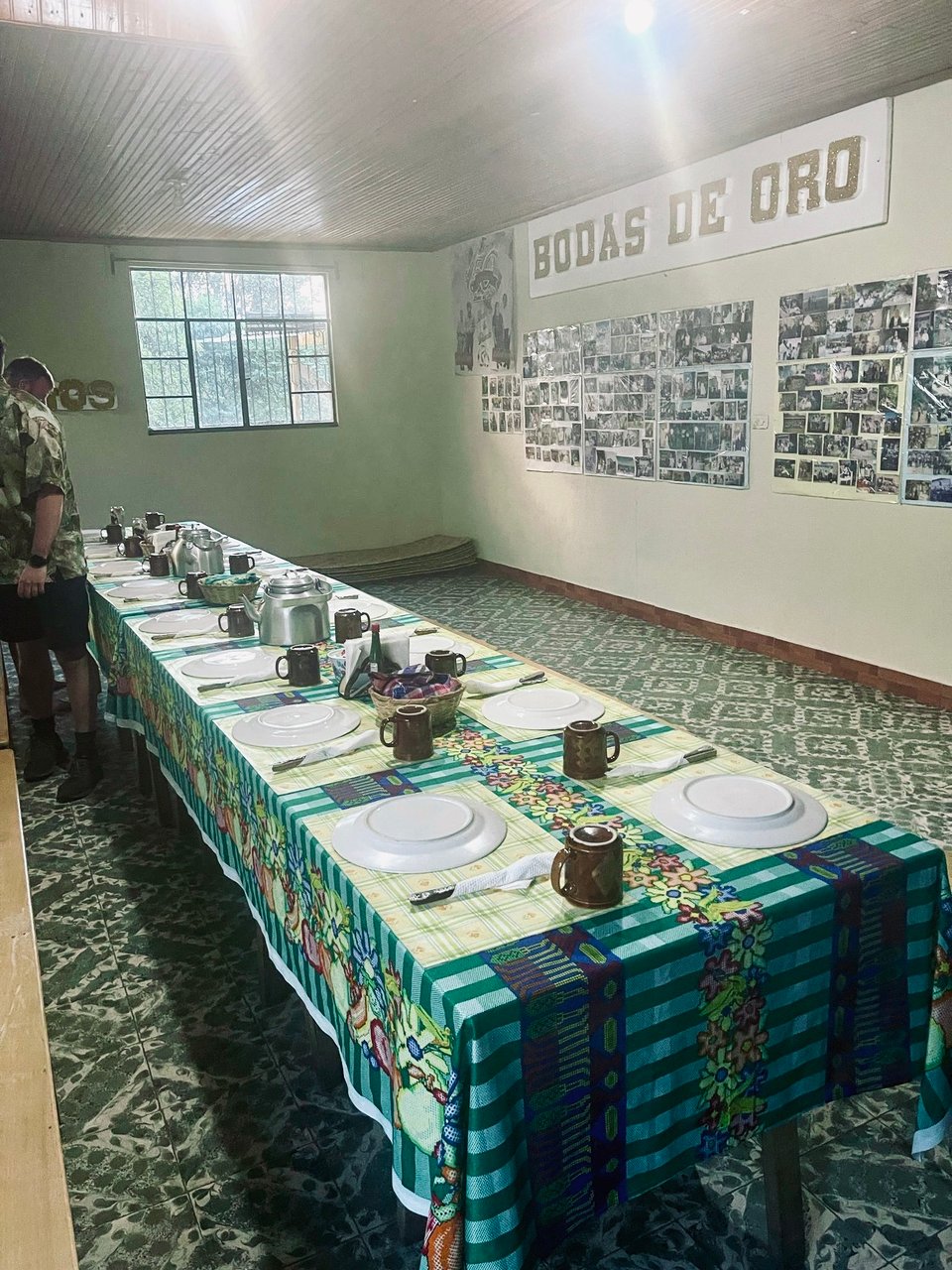
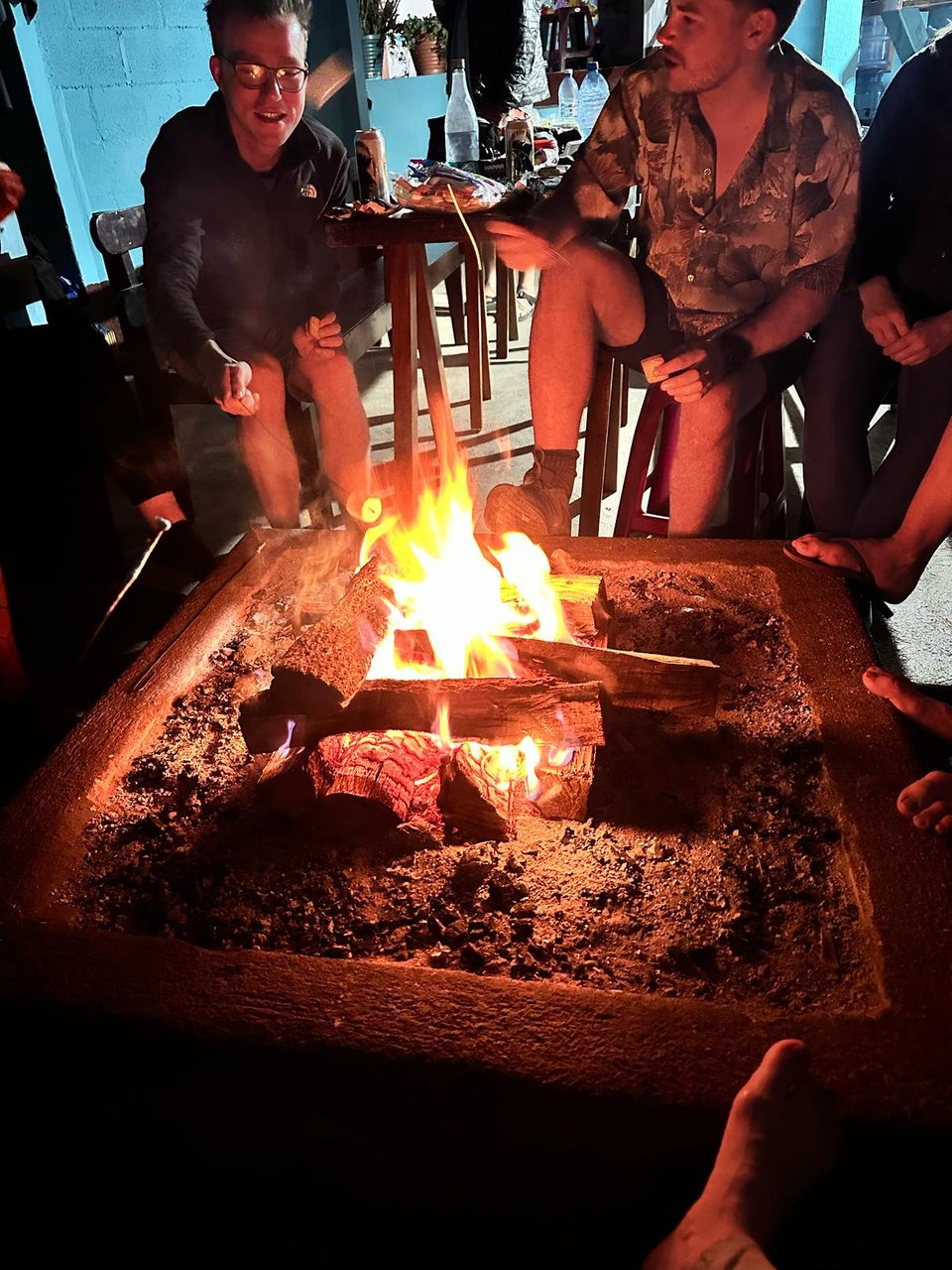
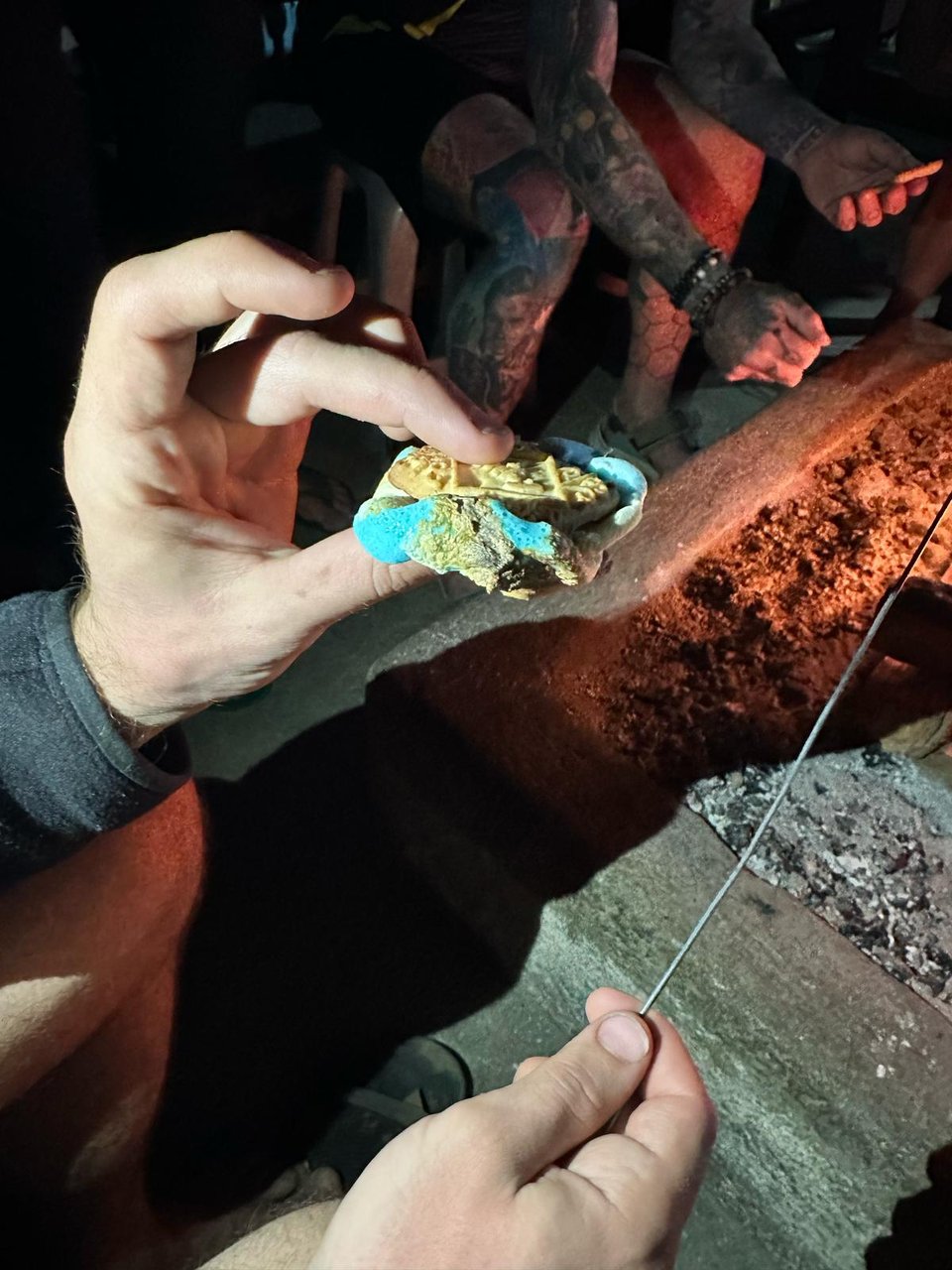
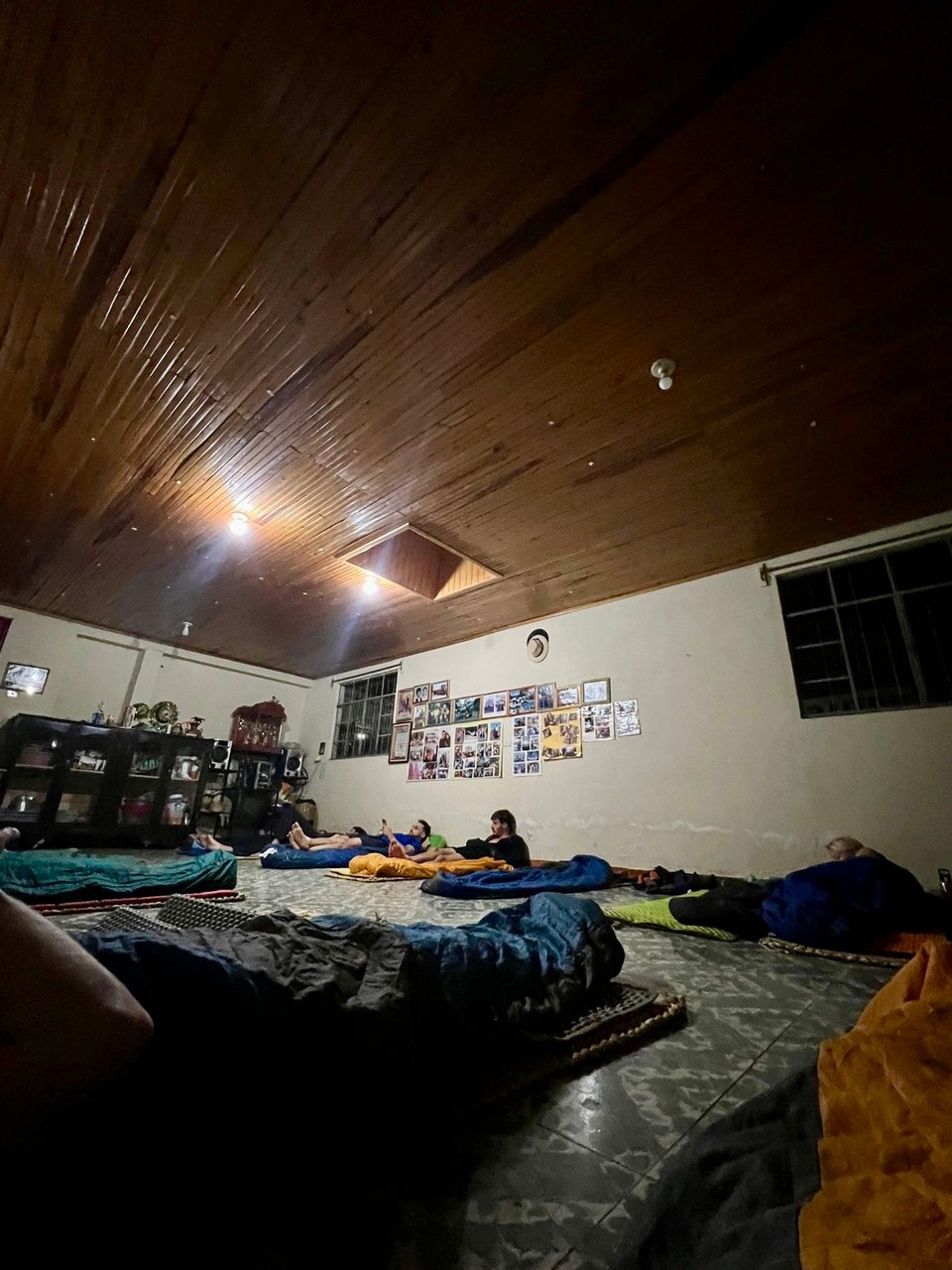
We all slept in the room we’d eaten in. It was the biggest sleepover I’ve ever had! I placed myself next to the door in anticipation of another night of getting up. Sure enough, I got myself into bed and within 2 minutes was overwhelmed with a need to get myself to a bathroom stat.
Everything I had eaten over the last 24 hours had just been sitting in my body, plugged up by the Imodium and it all came rushing out. It was indescribably awful, and pretty mortifying because everyone could hear. I wanted nothing than to be home.
I exited the bathroom and Sam and Meg adorably pretended to not know what had just happened, but as I walked toward them I realized I actually felt decent. I said nothing, trying to not jinx it and went and got back into bed for our 3:30 am wake up to go see the sunrise and finish our three day trek. We were so close!
Surprisingly and excitingly, I slept the entire night and as Quinn, Nathan, and Kim sauntered in blasting “The Final Countdown” at 3:30 to wake us up I recognized that I felt almost normal: As normal as one can for getting up at 3:30 am and having zero sustenance in their body anyway.
We walked about 45 minutes to our private sunrise location, stopping once to pick up our “friends,” a police escort provided by the regional government around the lake. At the overlook, Marieke and I snuggled into a joint sleeping bag together to wait for the sun to come up. The guides heated up water for hot drinks and breakfast while our little trekking family snuggled up and chatted. Below us lay the lake, surrounded by shimmering clumps that were clearly the towns.
Slowly, it got lighter and lighter and the sun peaked over the hills to light up Lake Atitlan and the surrounding volcanos, Atitlan, Tolimàn, and San Pedro. We soaked in our final sedentary moments together, geared up, and headed down to our final destination. Along the steep and rocky trail, we had sweeping views of the stunningly blue lake. The guides remarked that they’ve never had 3 days of such prime weather; we were a lucky bunch.
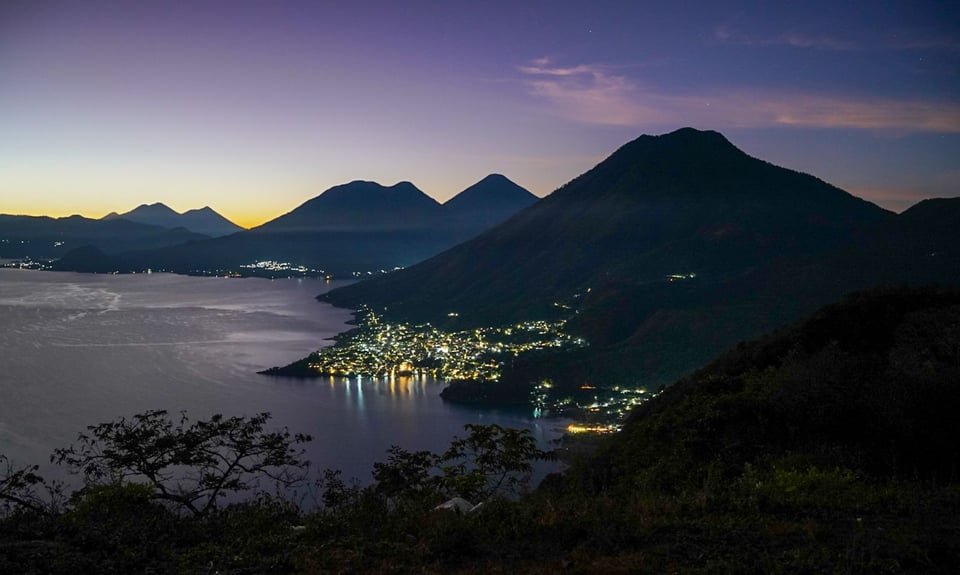
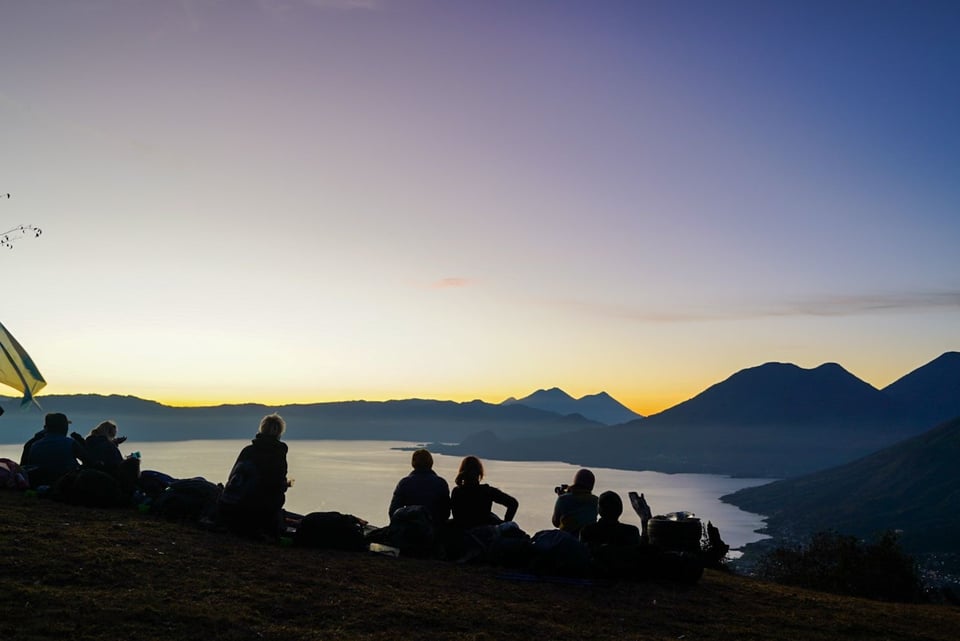

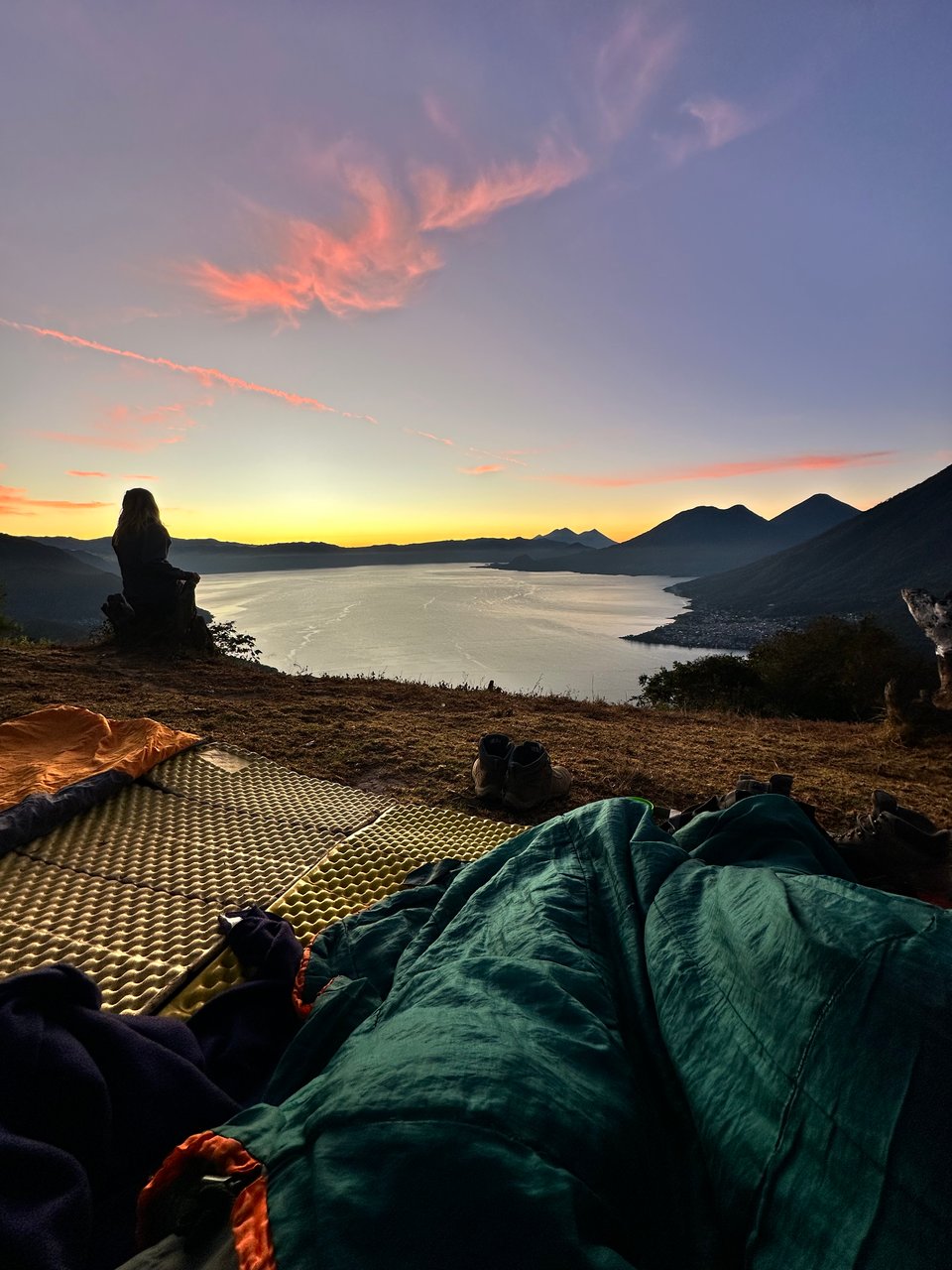
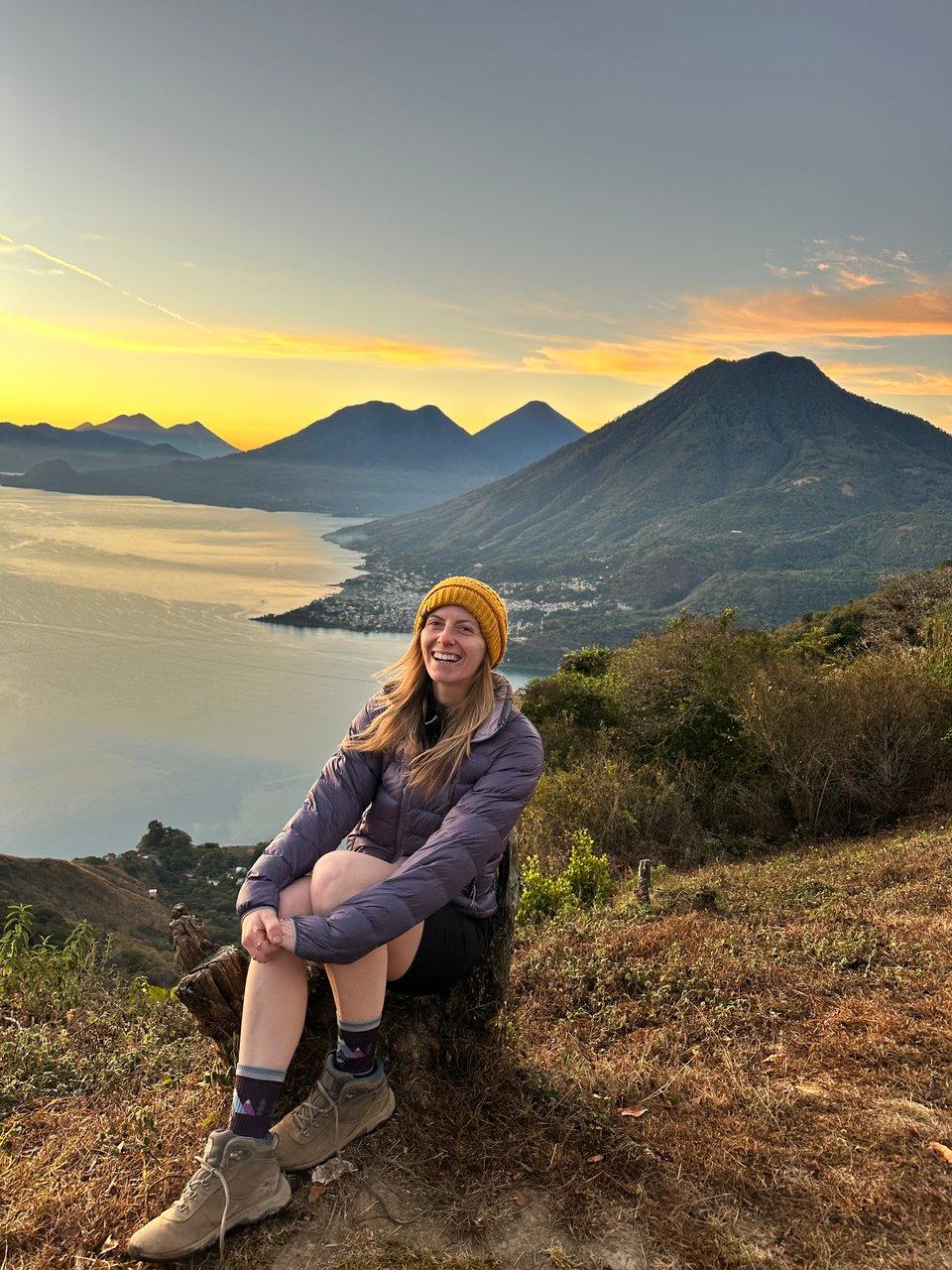
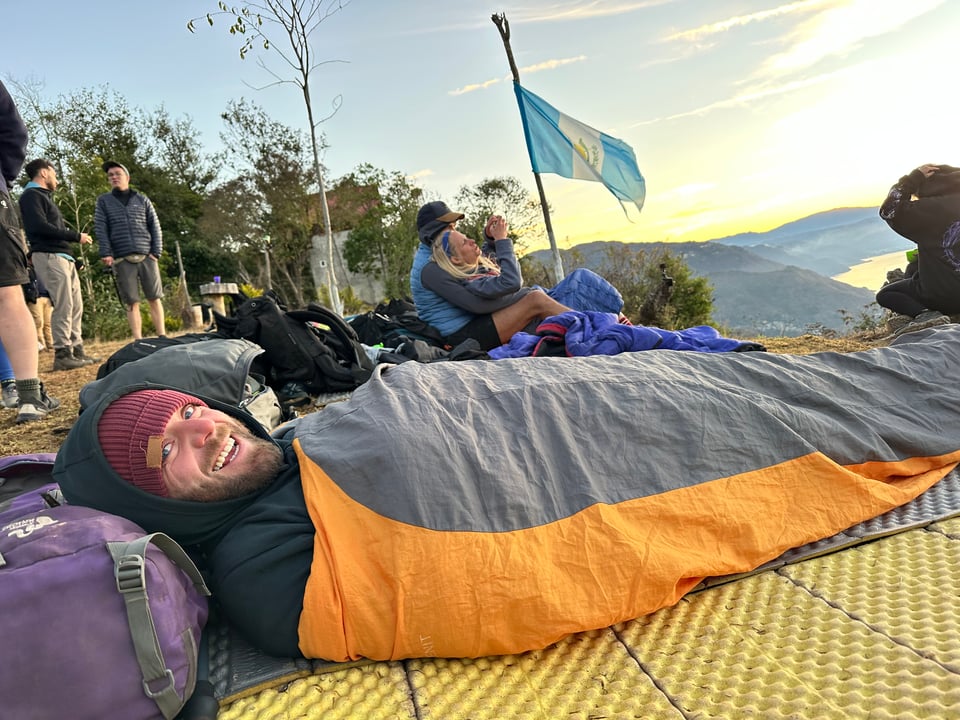
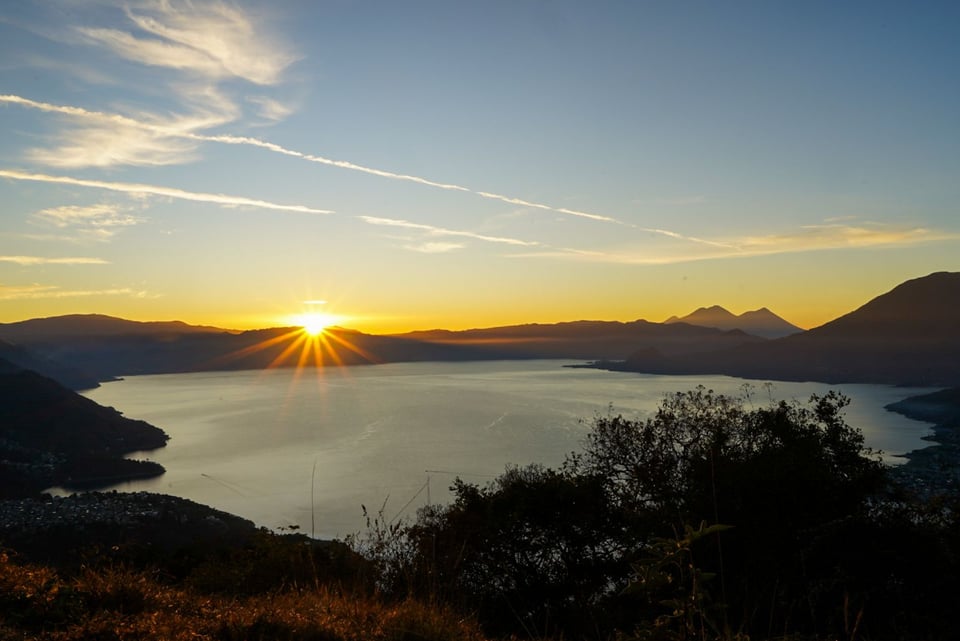
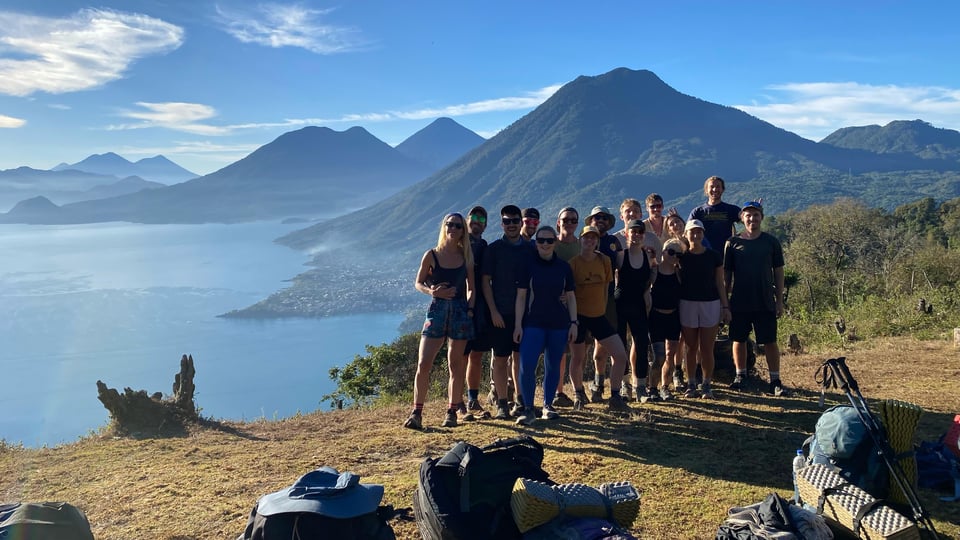
We exited the hills at the mirador in San Juan, an artisan town on the lake. Here, the guides had one final discussion with us; this one about the armed conflict in Guatemala that started in 1960 and lasted over 30 years. They discussed the democratic elections and processes that Guatemala was starting to implement, and the CIA’s complete undermining of these in the interest of economic gains. If you haven’t heard about this, as I had not, I heavily recommend looking into it. It is a shameful, not well known part of our past that resulted in massacres, poverty, and instability that has shaken the country for decades.
As if that wasn’t heavy enough, we were nearing the end of our time together. All that was left was lunch and parting ways. We loaded into the back of a pickup truck, a form of transport aptly named “pickup” and drove to the neighboring town of Sam Pedro where we ate and the men all jumped off the second story into the lake.
After being sick I had zero interest in getting in water that I’d heard mixed reviews about, and that clearly wasn’t all that clean - there was a dead fish and some garbage visible in the water by the restaurant. I happily cheered them on, soaking in the sun and joyful chatter.
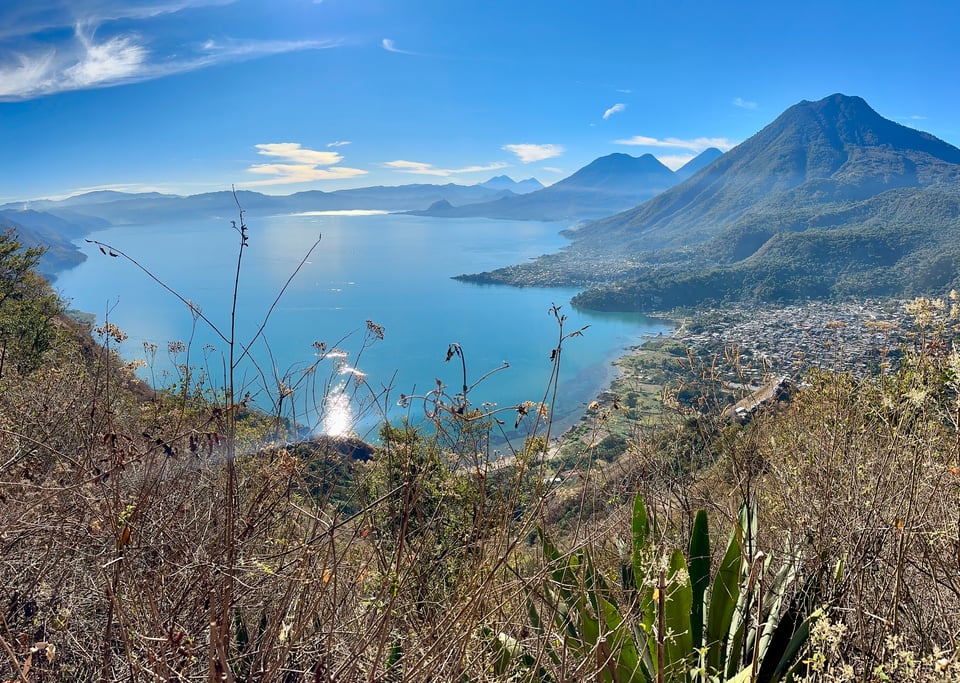
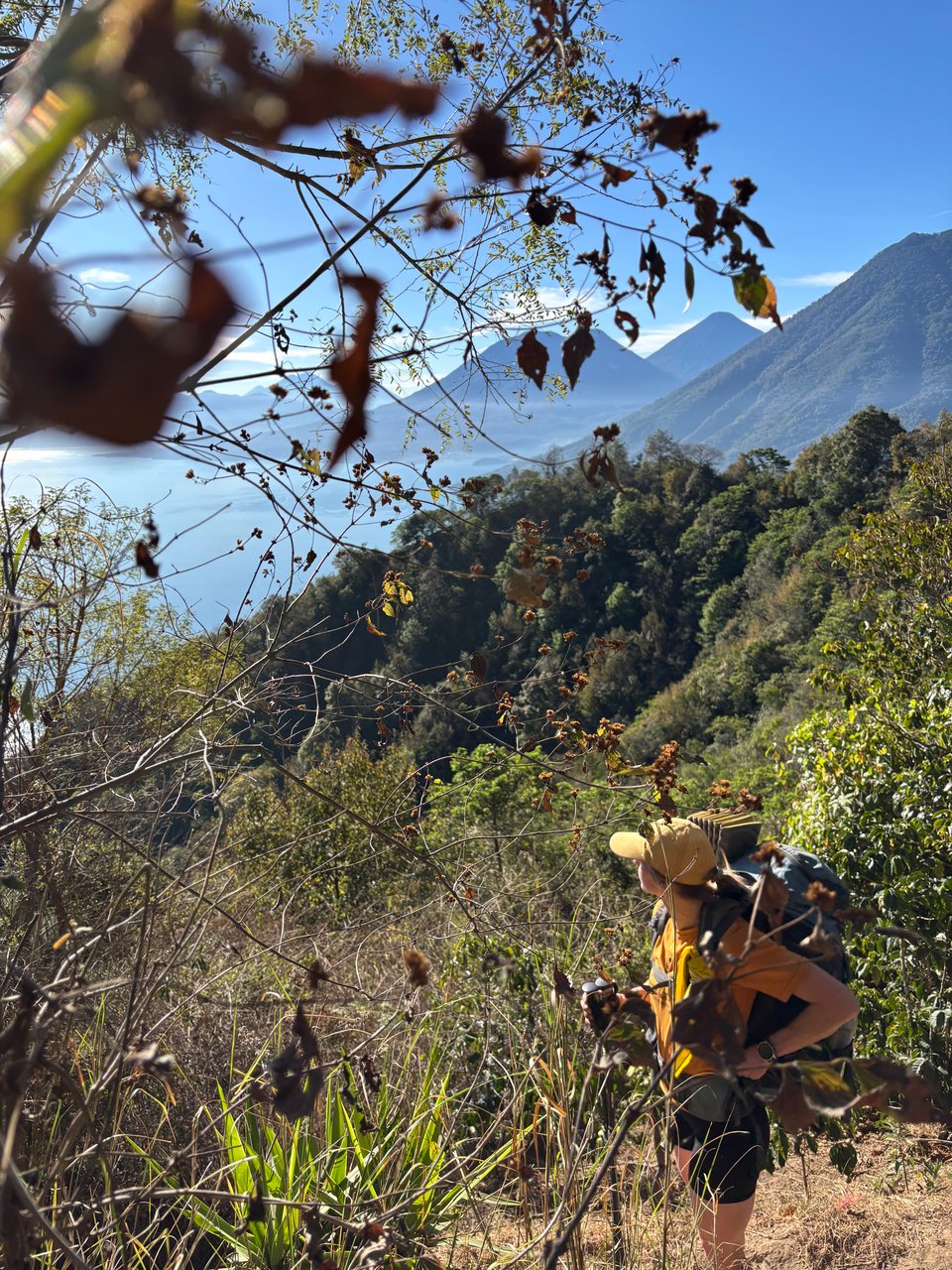
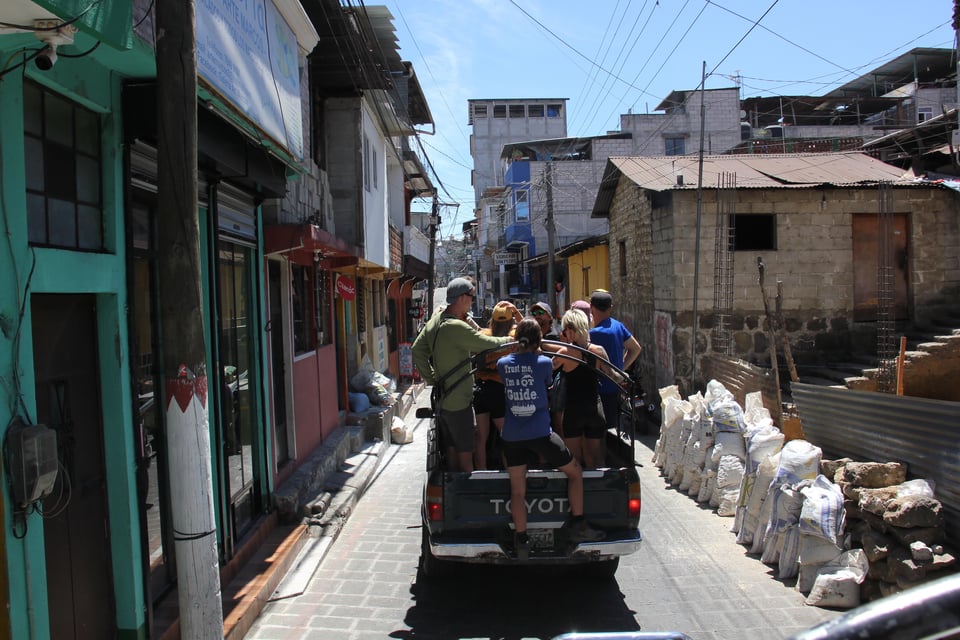
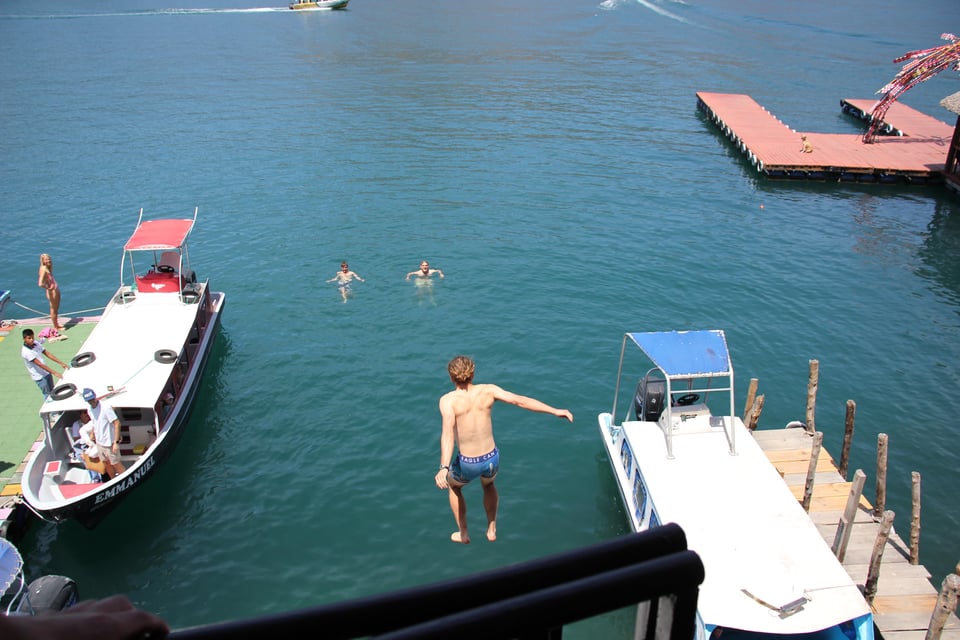
Sam, Meg, and I took a boat across the lake to San Marcos and walked to the hostel where we were all coincidentally staying. It was nice to have their company still, especially after they’d been so nurturing toward me. As we walked from the boat to the hostel I was getting flashbacks to home; everyone had said San Marcos was like Sebastopol but I didn’t realize that it was as though half the people of Sebastopol had been transplanted to Guatemala. There were spiritual awakening/meditation/yoga signs and posters everywhere, a deep incense and palo santo smell, and willowy, long haired, braless women arm in arm with dreadlocked men all around. We were not in Guatemala anymore, that’s for sure.
I spent my evening relaxing on the hammocked rooftop overlooking the volcano and making a light plan for my days to come. I knew I didn’t want to stay in San Marcos the whole time; it was small and not authentically Guatemalan in any way.
The next day was Sunday, which I had been told was esctatic dance in the neighboring town, Tzununa. It started at 4:00, so I had a slow morning at the cafe in town, Circles. I, quite to my delight, ran into Marieke and some girls from her hostel in Santa Cruz. I spent the day with them at the nature reserve in town, which has many rocks for lounging on beside the lake, as well as a 12 meter jumping platform. We stationed ourselves near it so we could switch between reading and watching the daredevils jump all day. I, not being much of a water person and still being terrified of getting sick again, opted out of swimming even.
By the time I left to go get ready to dance, I’d apparently fried myself to a crisp. Sun at altitude is so unforgiving… it didn’t stop me from dancing the night away in the middle of the forest with my roommate, Linda. We laughed and wiggled. I swung on silks with a young boy who was delighted to have an adult want to engage with him during the dance. We left sweaty and beaming.
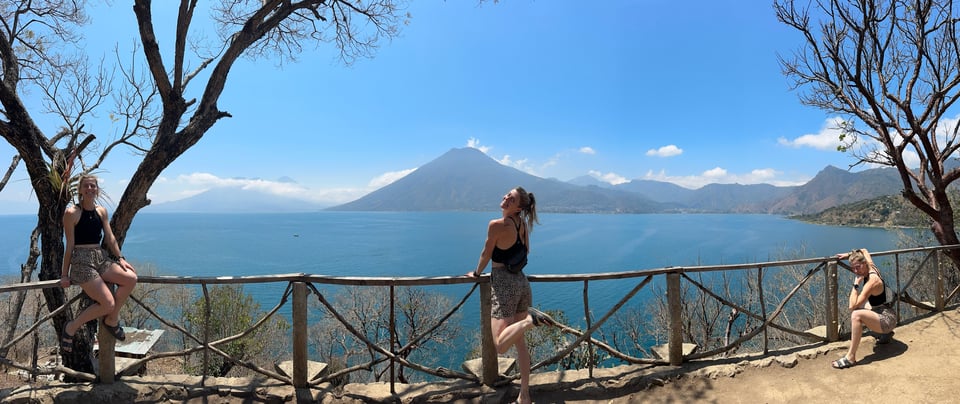
The following morning I found myself at Circles again. I couldn’t stay away from their bread, coffee, and açaí bowls… I confirmed plans with Marieke to do our cooking class in Santa Cruz that evening, and then I set out on a 6 mile walk from San Marcos through Tzununa, Jaibilito, and to Santa Cruz. It was brutally hot, and I was extra covered to protect my already crispy self from the harsh sun. The views were stunning through as the trail traversed through small, quaint towns, forests, and coastline. I came upon massive garden oasis resorts nestled into the hills, locals cutting trees, and chickens blocking the path. I couldn’t guess what I’d come upon next.
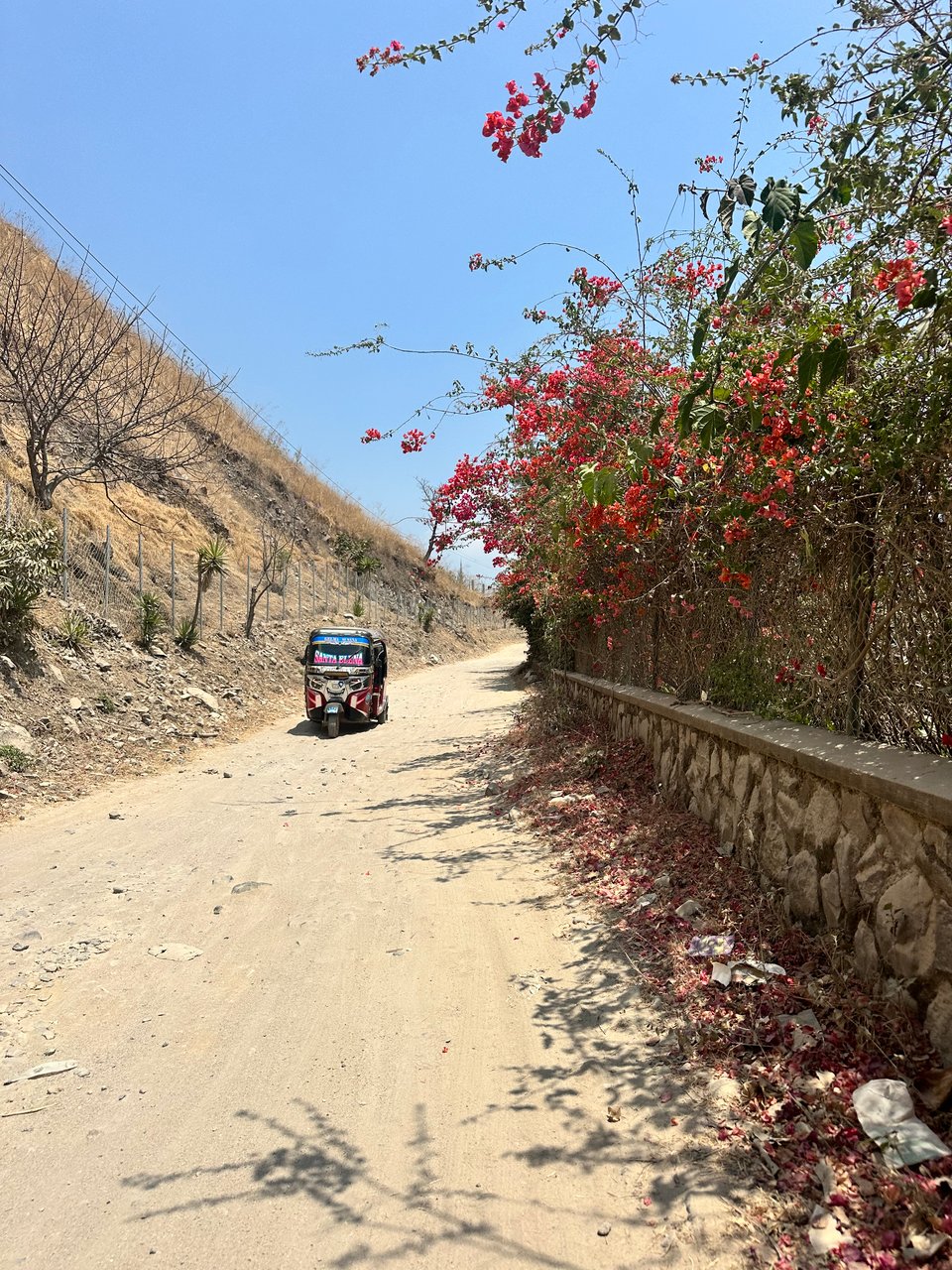
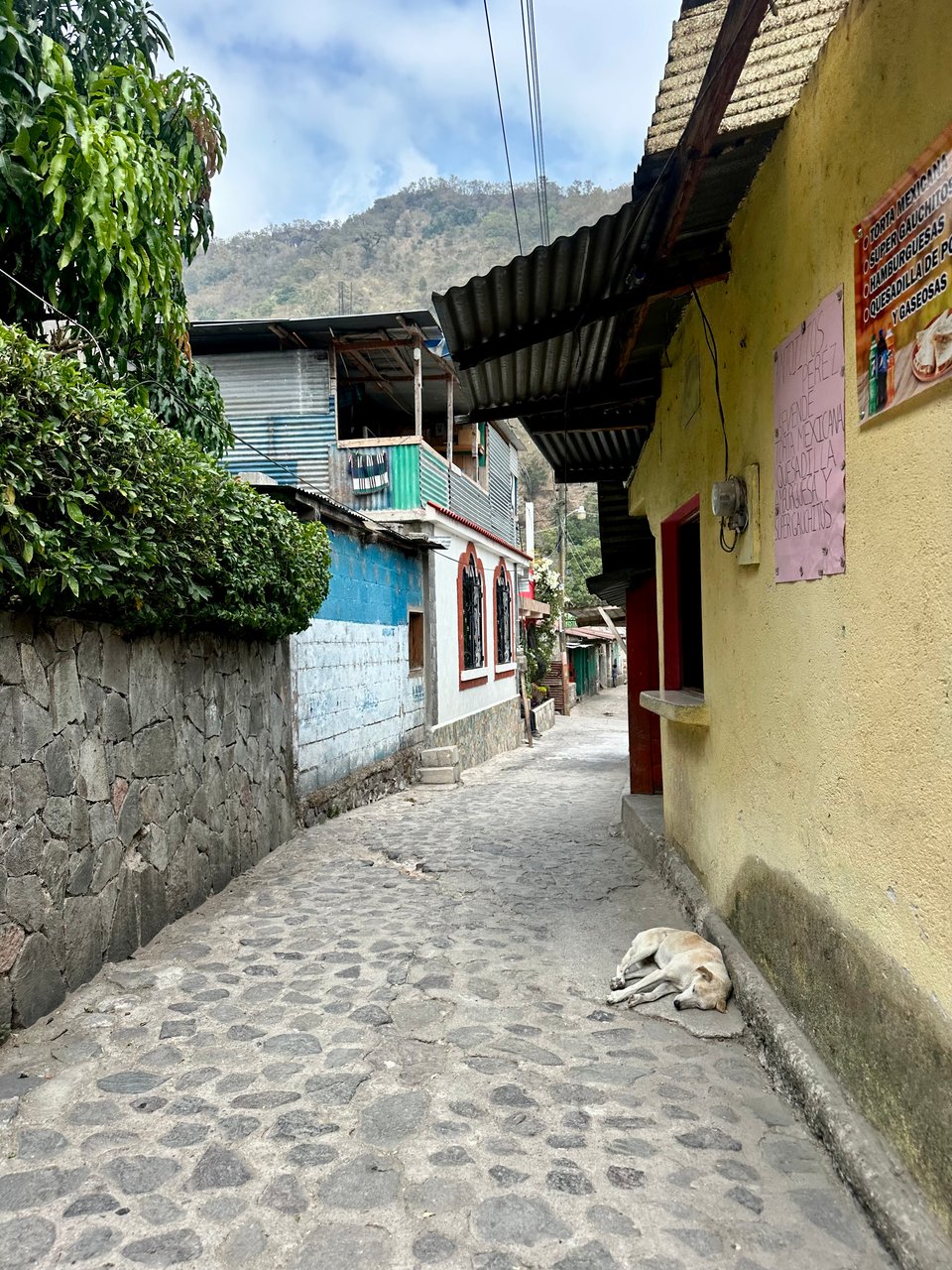
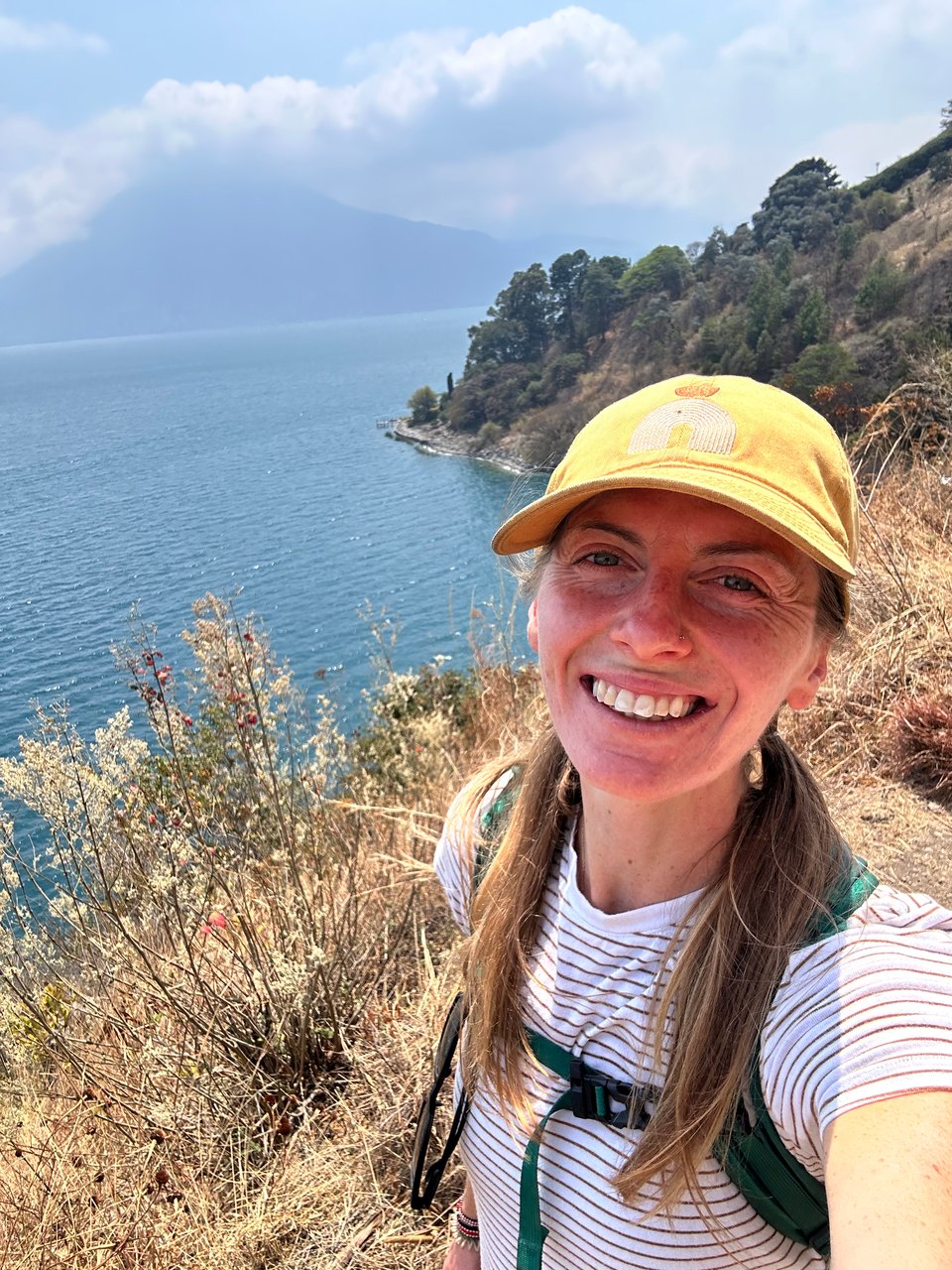
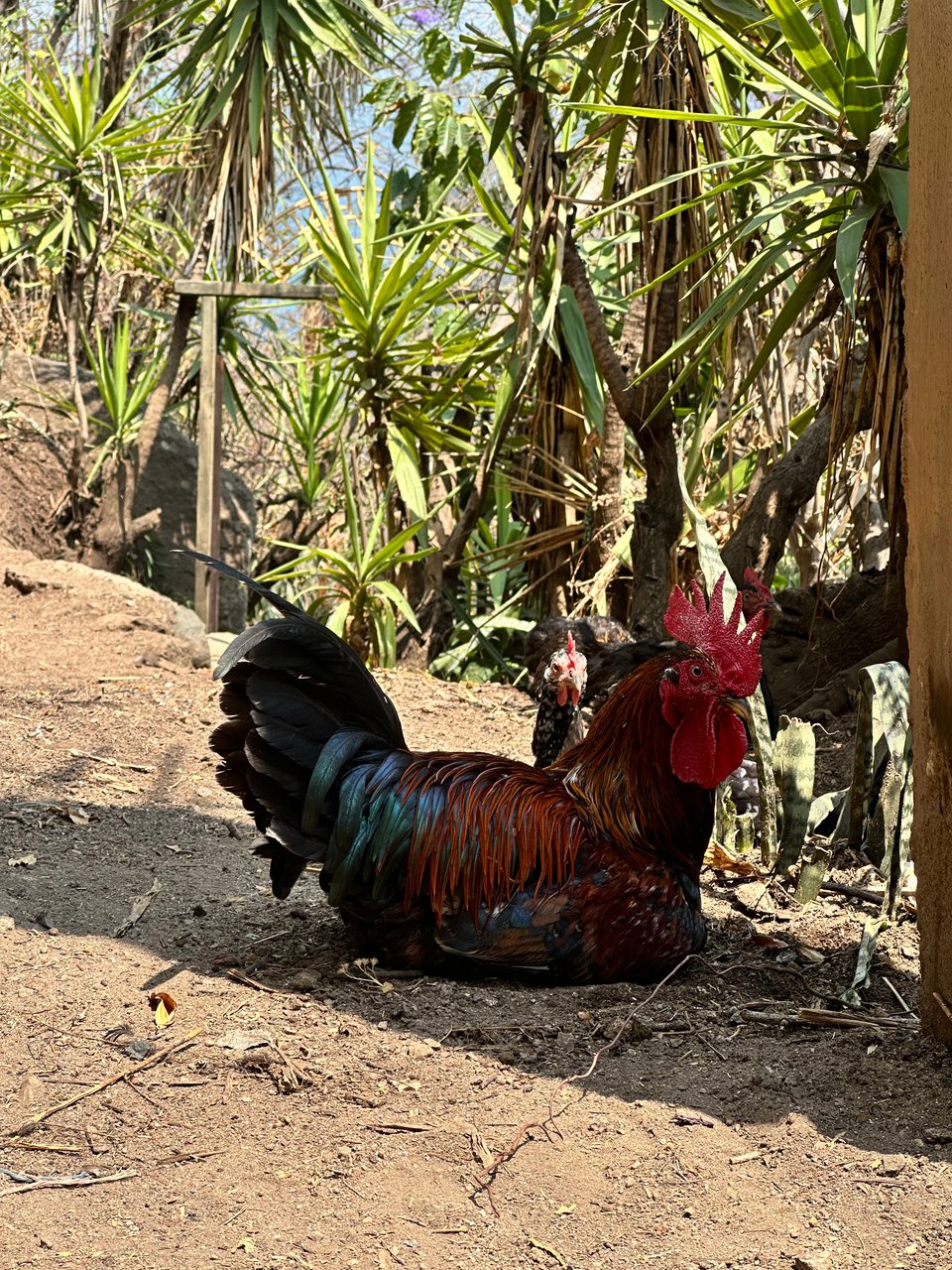
By the time I got to Santa Cruz I was drenched in sweat and ready for a refreshment, but as my luck would have it, clouds and a wind storm started to come in. I quickly became quite cold and realized I’d broken my golden rule: never leave without layers.
I sought refuge at Marieke’s hostel until she arrived, using my quick dry towel as a blanket to try to stay warm.
She showed up at our planned time and we trudged our way up the massive hill that takes you from the docks to town. We were meeting a woman at her home to learn to cook pepian, a traditional Guatemalan stew flavored with chilis and roasted spices. There was a massive language barrier for myself and the two French people that joined the lesson, but luckily Marieke spoke pretty decent Spanish and helped us through the multi-hour course. The adorable older woman, Katarina, didn’t really use a recipe and just gave us tasks here and there, such as picking leaves off sprigs of herbs, peeling tomatillos, roasting tomatoes and spices, browning rice, etc. She threw the ingredients we prepped into pots or blenders without much explanation, and it became clear that traditional dishes like pepian are not made by following recipes necessarily, but instead by feel and judgement you develop as you are shown and participate in the process growing up.
At one point, her daughter arrived and taught us how to make tamalitos de chipilin, which is essentially a tamale without anything inside. We mixed the corn flour with chipilin, a green leafy vegetable native to Guatemala, and then put an elongated handful of it into the base of a banana leaf, folding the leaf until the tamalito was wrapped and ready to steam.
We then used corn flour to make tortillas. Everywhere you turn in Guatemala there are women making tortillas. As you wander the streets of any town or city, you can hear the smack of the wet corn flour mixture against their hands. We learned that girls learn to proficiently make tortillas starting at 6 years old, which became quite impressive as we tried and had every single attempt fail. It kept sticking to our hands, no matter how gentle we were, or in my case, it would get dropped and fold in on itself in its plummet to the table. I walked away with serious respect for the women and girls I’d seen making piles of tortillas daily.
As we finished the tortillas, we were shown how to roll them with potatoes inside and fry them to make a version of empanadas. Our little group of four started to get quite confused as to who was going to eat all the food we were making…
As each piece of our meal finished cooking, Katarina’s husband, Jose, came home, as well as one of her sons with his wife and son in town. Everyone sat around their table and had their fill of the rich, flavorful, and hearty meal we’d just prepared.
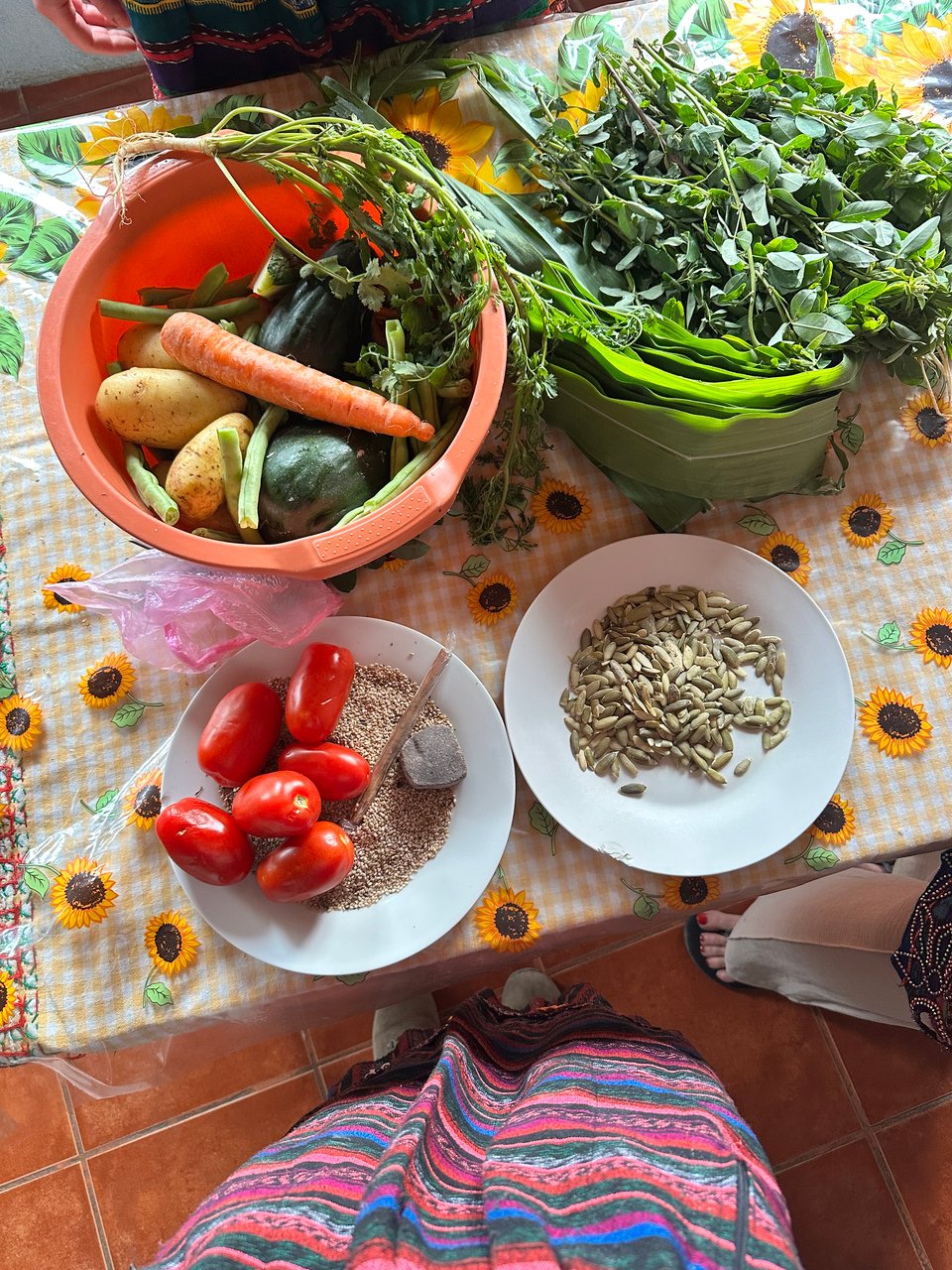
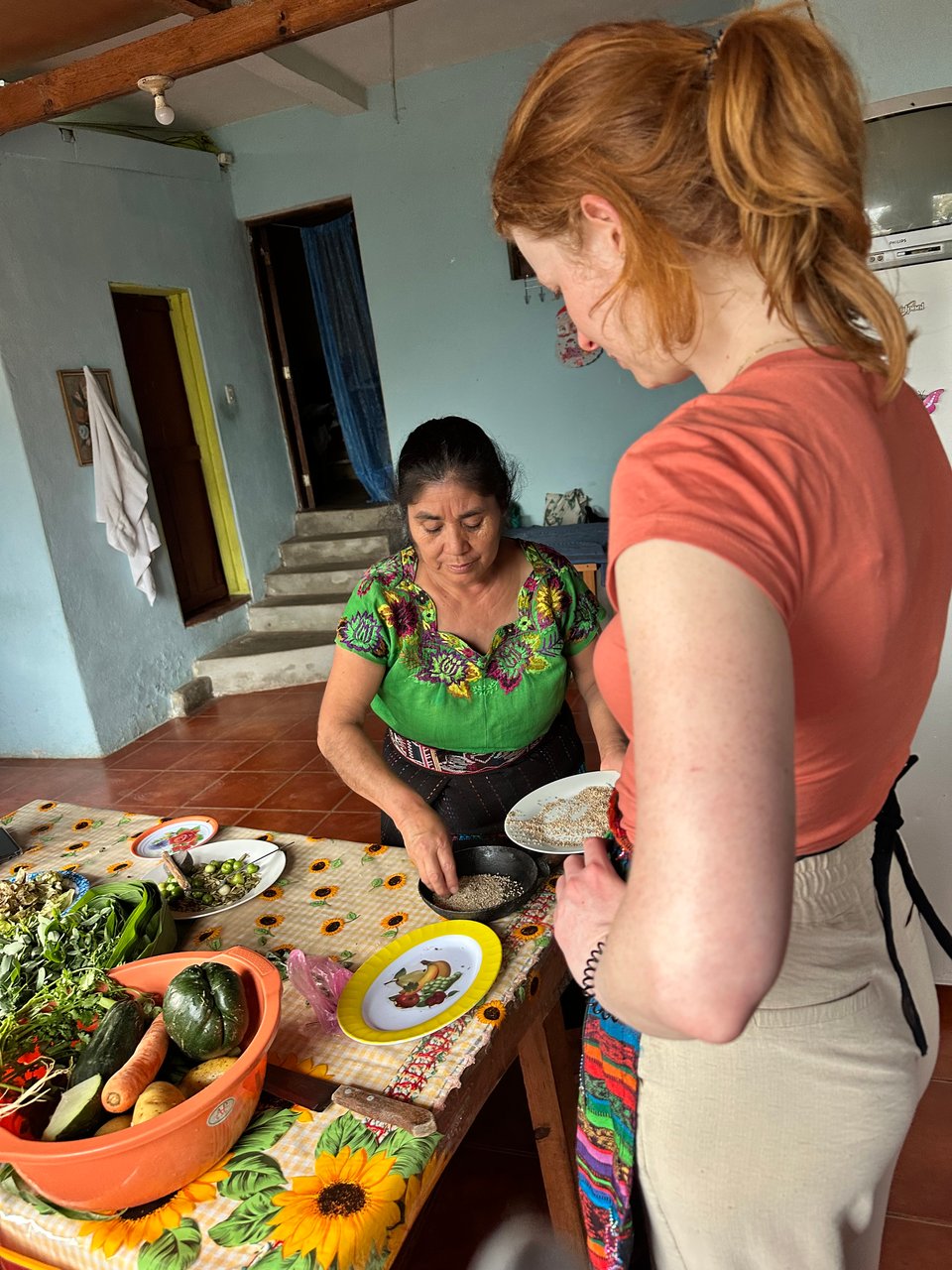
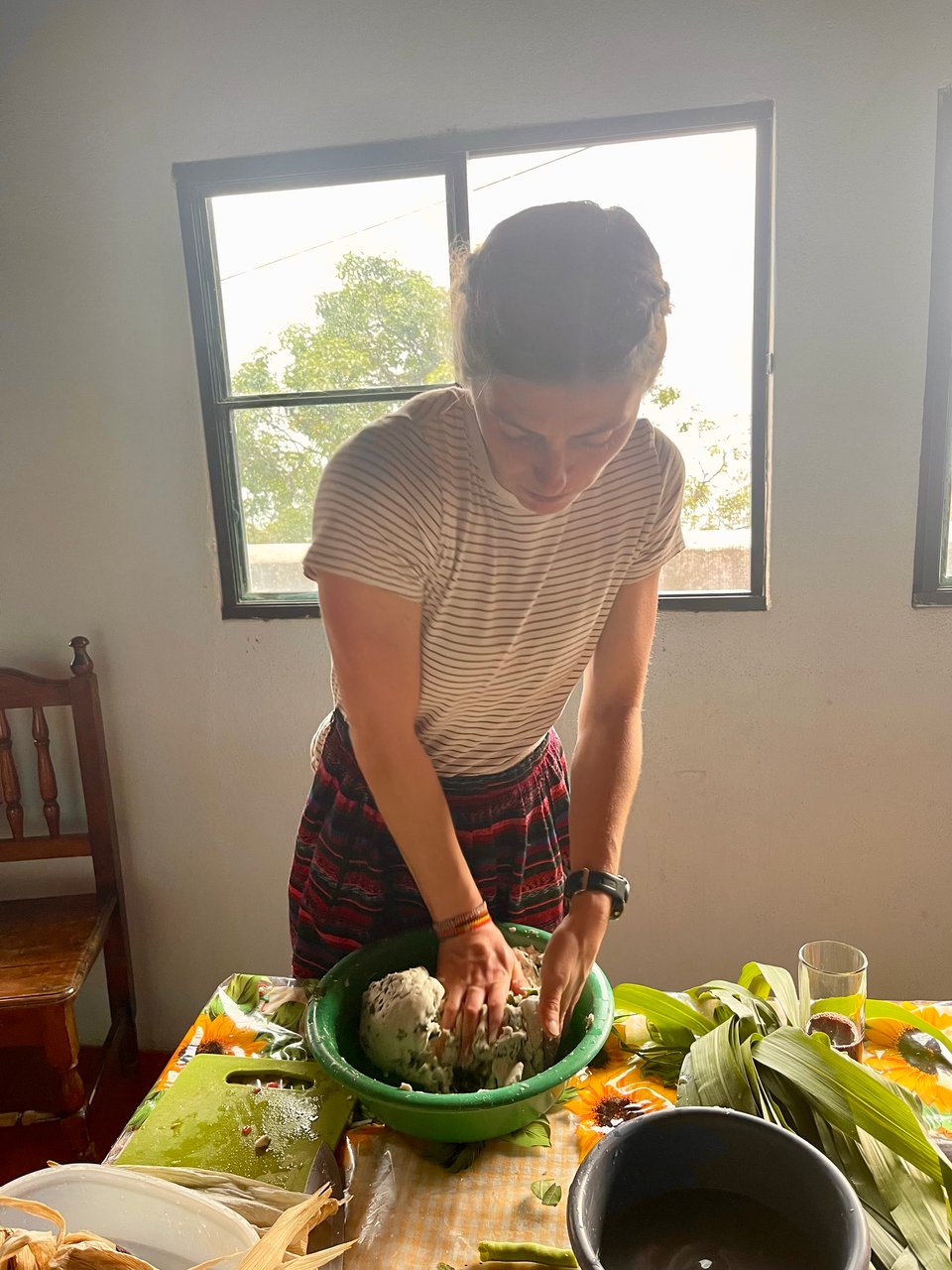
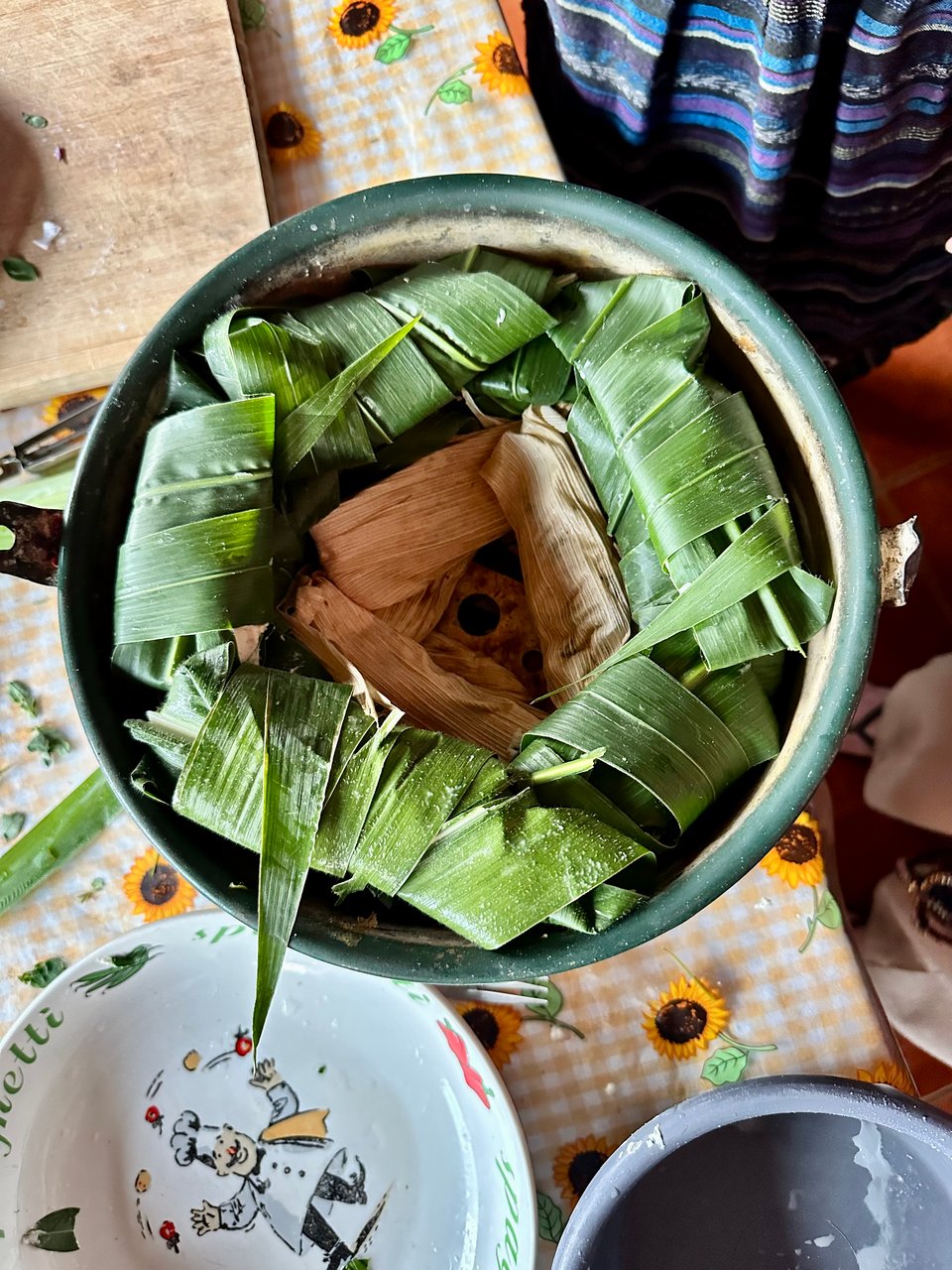
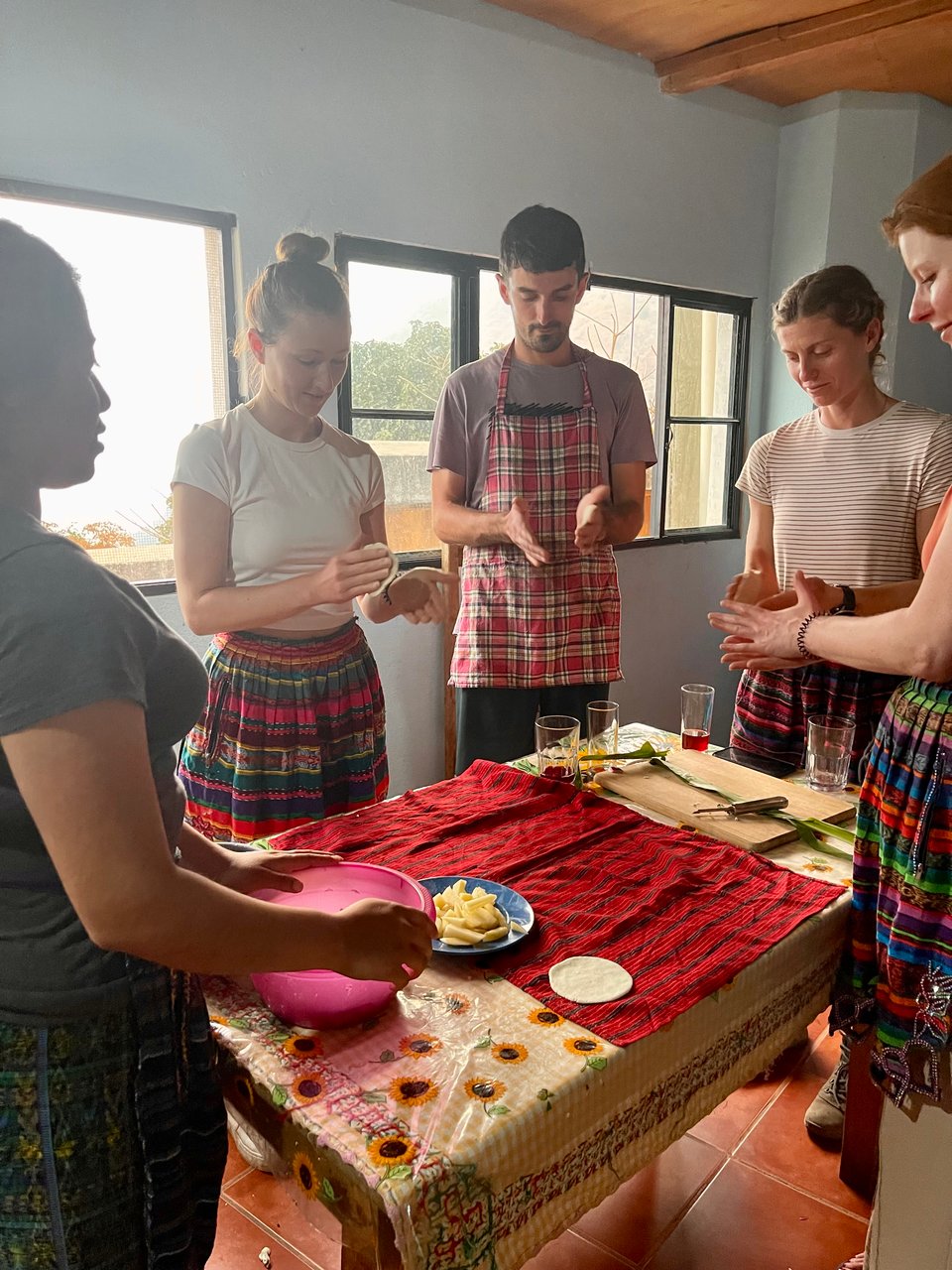

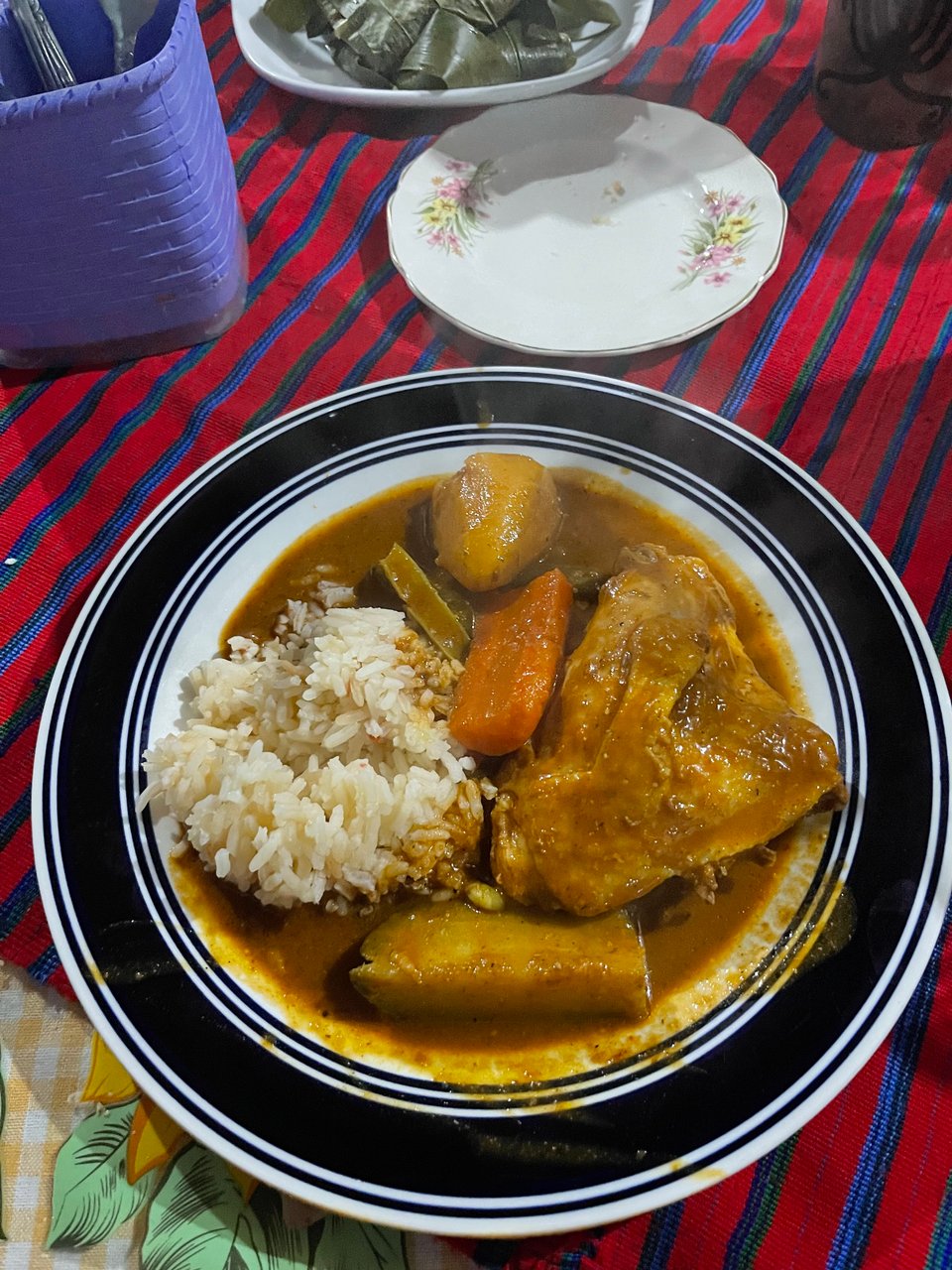
My final day at the lake I chose to go to the artisan focused town of San Juan. It is known for amazing painters, weavers, and food products such as honey, chocolate, and coffee. I mapped out a few things I wanted to do and see and set up an afternoon class to learn traditional Guatemalan backstrap weaving.
Once off the boat I wandered through the vibrant city, noting how colorful it was compared to the other towns and cities I’d been in. It was clear the town was home to artists, as most walls had massive, detailed, colorful murals covering them. I spent the morning wandering toward a cacao company that was said to have free informational tours. Once there I got a rather short demonstration on how they make cacao into chocolate. I asked a few questions about ceremonial drinking cacao and in my curiosity was joined by an equally as curious German woman, Alicia. We learned that the cacao in these ceremonies is not special in any way other than that it is pure, and that the ceremonies are really just for a reset or cleansing, a leaving behind and turning over of a new chapter, much like we hope for in our new year or on birthdays. Alicia then, surprisingly, asked to spend the day wandering the town with me. I took her to my next planned stop, a stingless bee garden where they produce a variety of honey products. Along our route we saw some of the most realistic and jaw-dropping street art; I was blown away at how the subjects seemed to be so present and life-like.
At the bee garden we did a little tour of each of the different bee hives. One species was so tiny that we mistook it for a gnat or mosquito! Our guide then gave us a tasting of the various honeys and products, and after purchasing some tasty treats we left to get lunch before my class. Having a companion was great, but messed my timing up a little, so I unfortunately had to rush to eat and then literally run to get to my class on time.
I was delighted to find that I was the only student that afternoon, which meant that the weaving expert, Amaria, and I got a ton of one on one time. Over the course of the 3-hour class I learned how to use the various parts of the backstrap loom setup. I learned the steps:
1) pull up to separate the strands
2) slide the wood through to hold them separate and then feed the thread through
3) compact the thread downward, using the same piece of wood
4)slide the wood through the second set of separated strands, feed the thread through and compact again
Amaria was patient and encouraging, but held me to a high standard and didn’t let me leave mistakes. Well, except the one I made while she was away checking on Fabian, her 8-year-old son, and that I was too far past to undo. When she saw it she said “we will call that history and you will learn from it.”
And learn I did! By the end of the three hours I had an entire decorative wall hanging to take home with me. Throughout the lesson we spoke a little in Spanish- she was so patient with me there as well- and she showed me a few different techniques for adding colorful, decorative flair to my piece. When I was satisfied and sore, she took over and did the finishing for me, doing what seemed like just as much work as I’d done, but in 10 minutes instead of three hours. I recognized it was also my first day and she’d been weaving since she was 8, the age that she said most girls learn the craft. Despite how I felt about my pace, she claimed I was a fast learner and celebrated my beautiful handmade piece with me.
I left San Juan proud of myself, grateful for Amaria and her knowledge and kindness, and excited for tomorrow when I would leave the lake and go to Antigua for my final days here.
